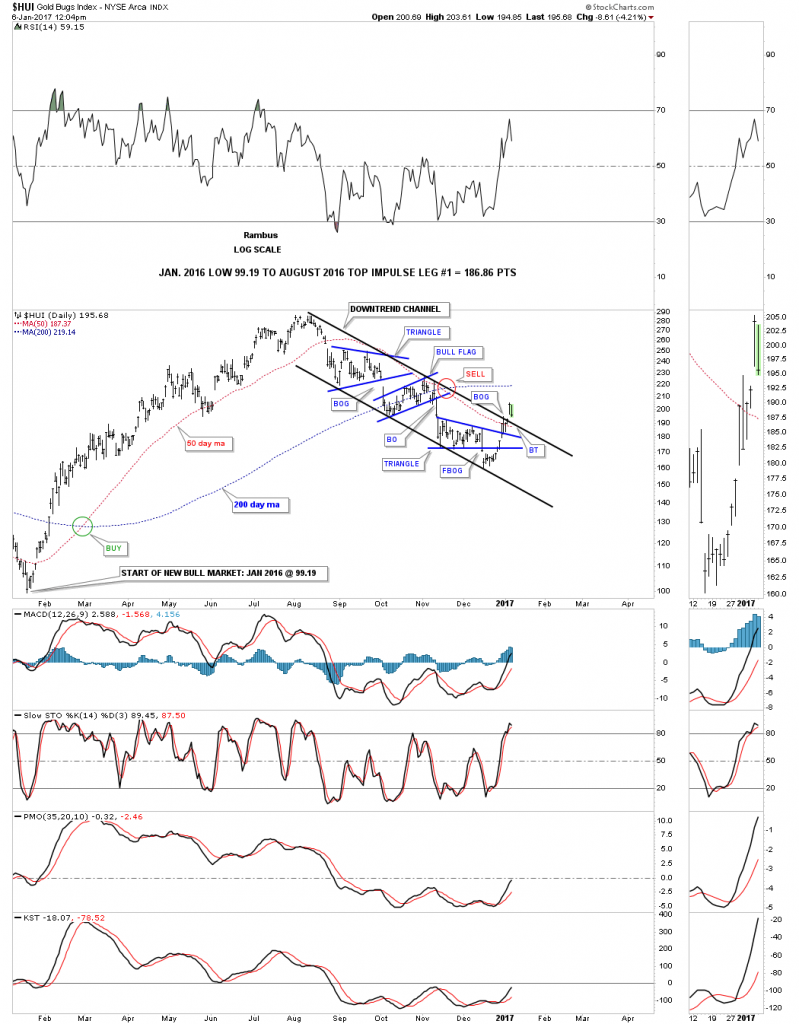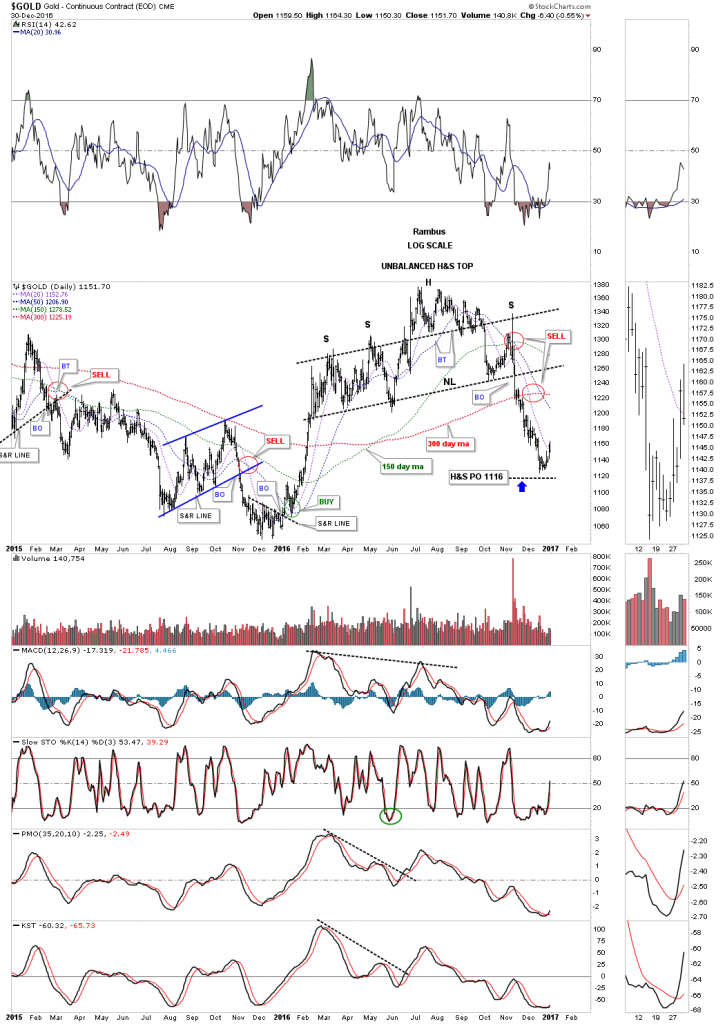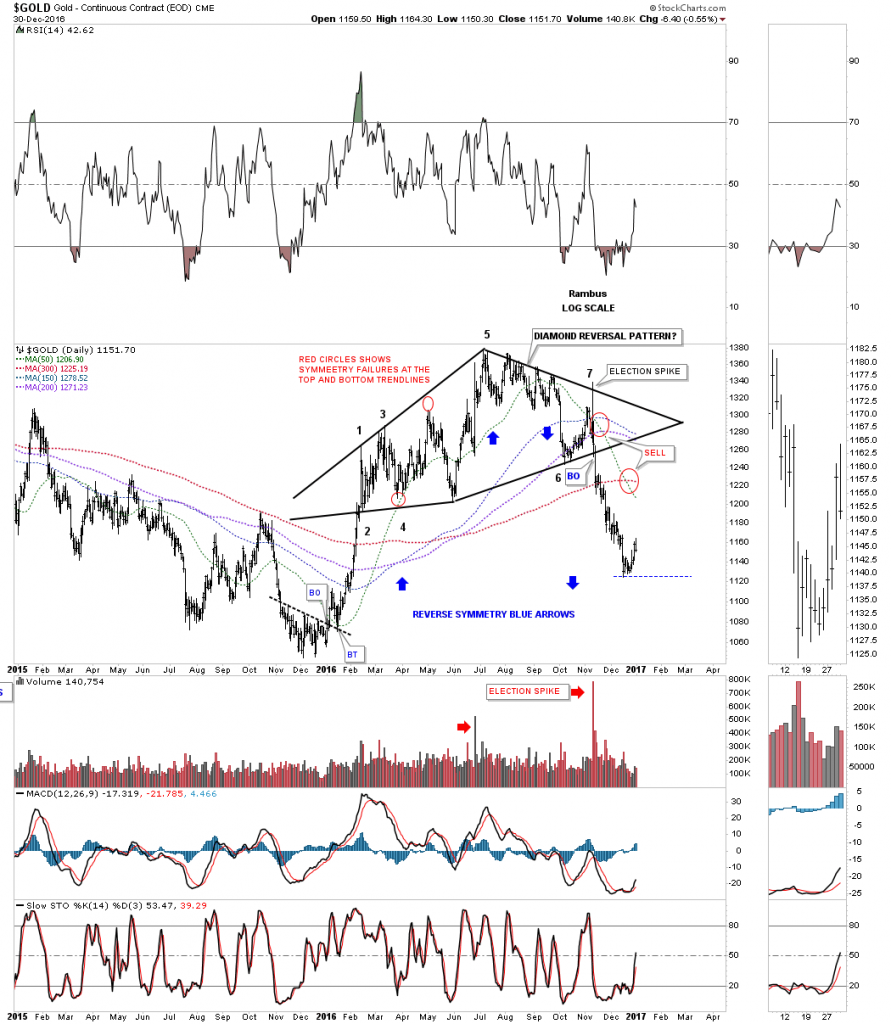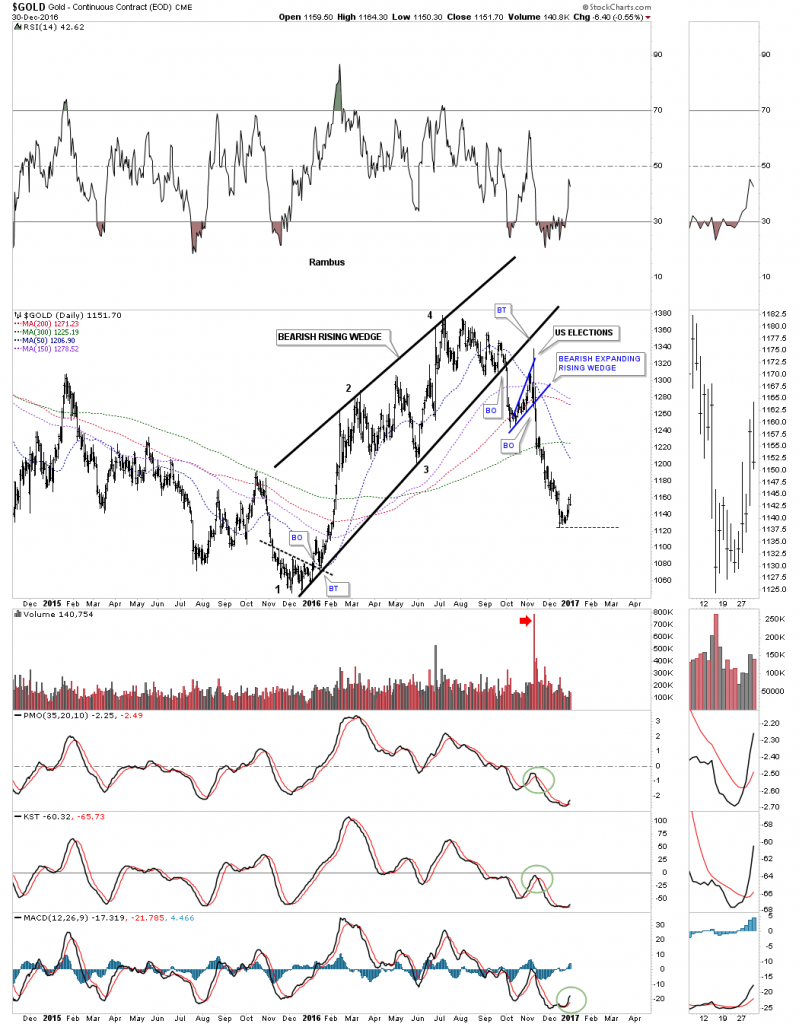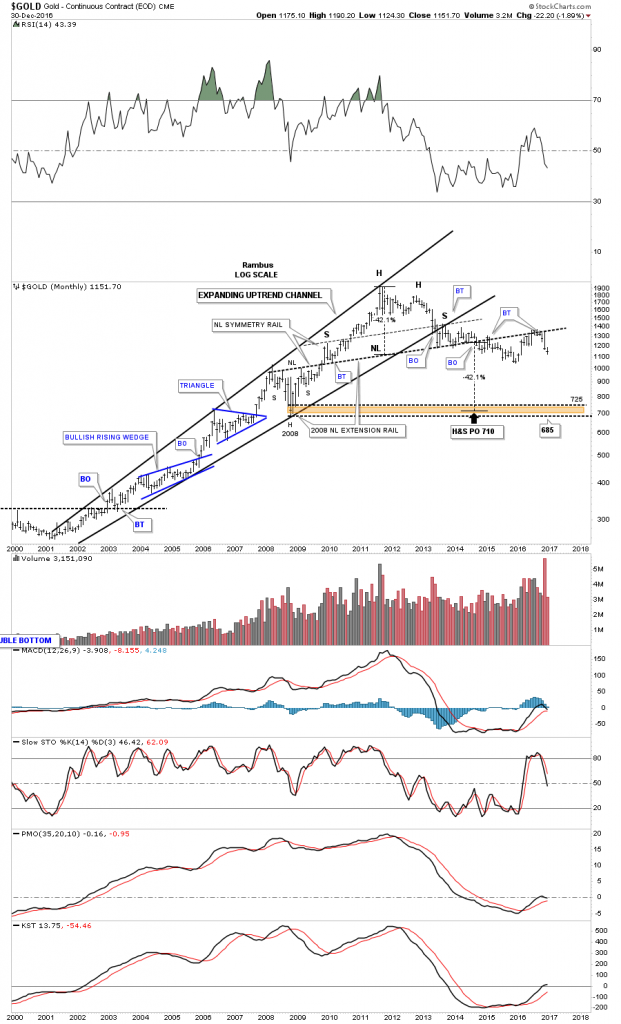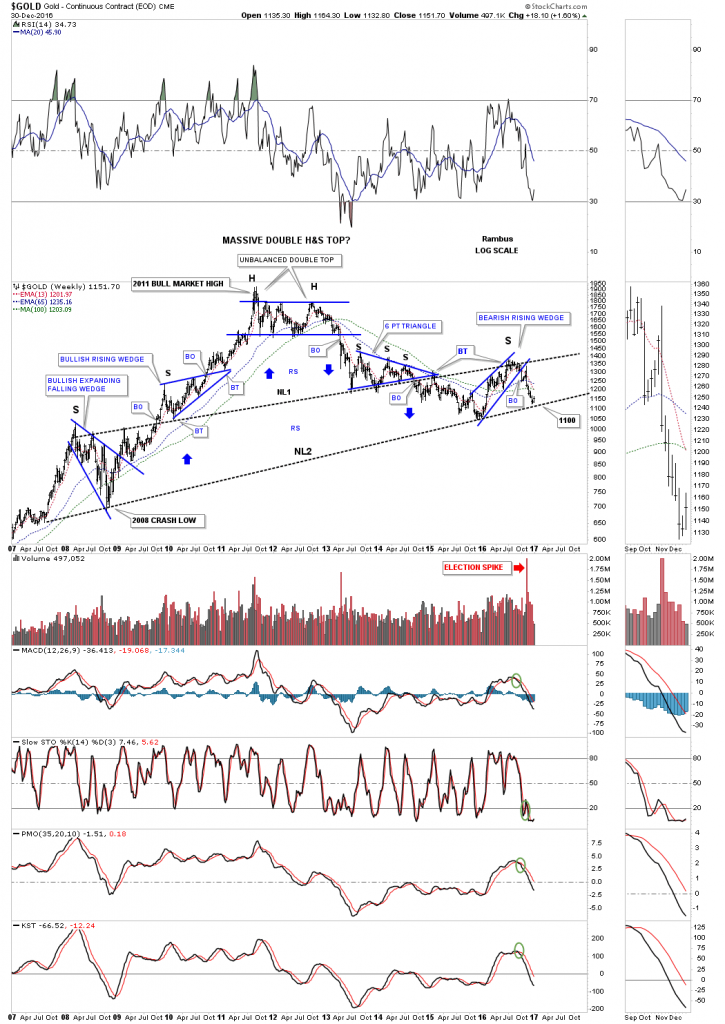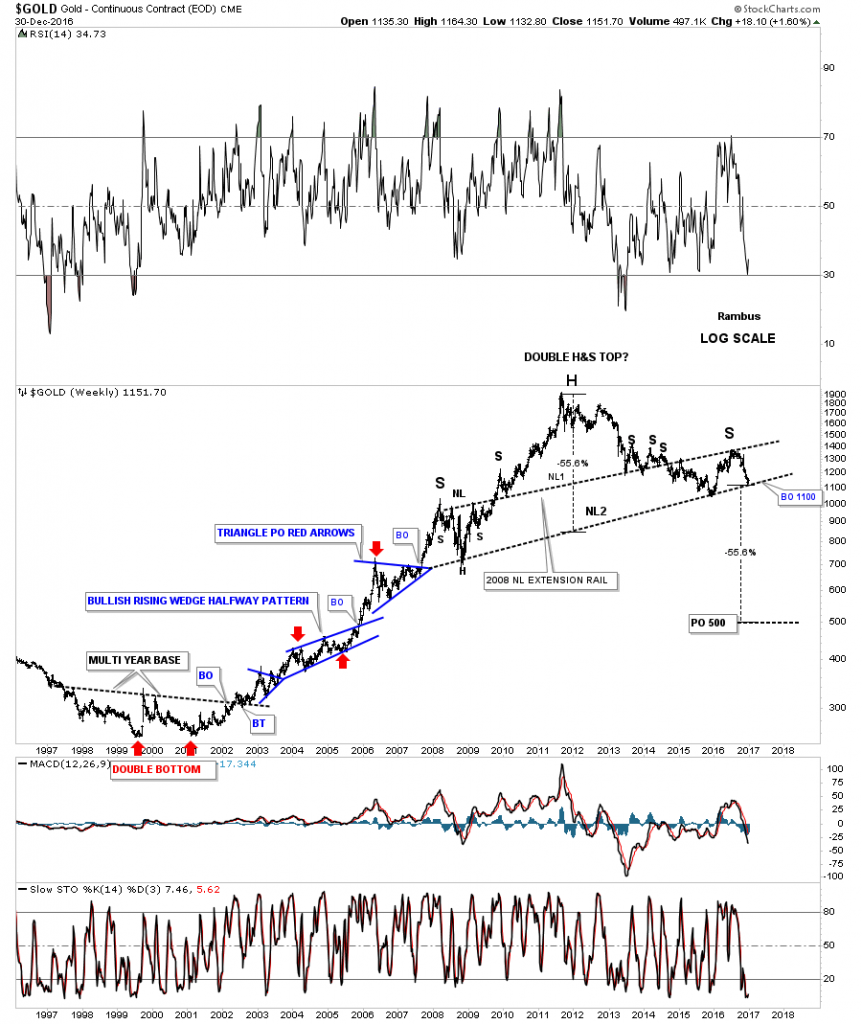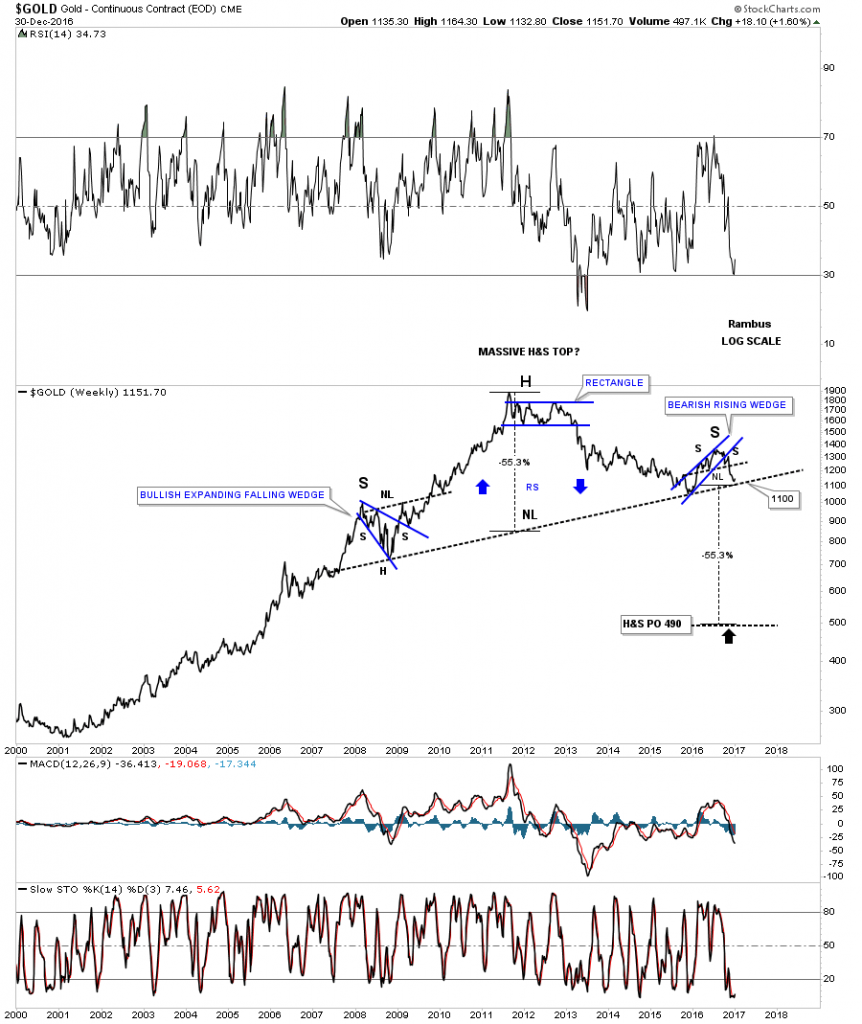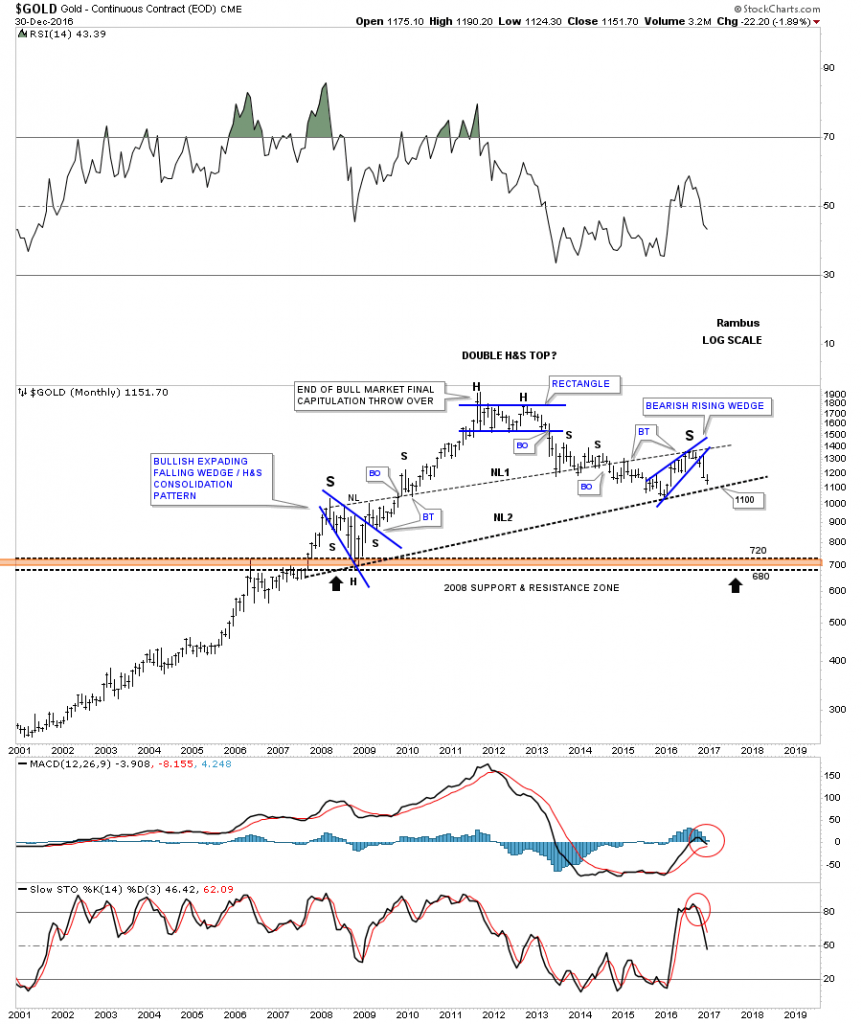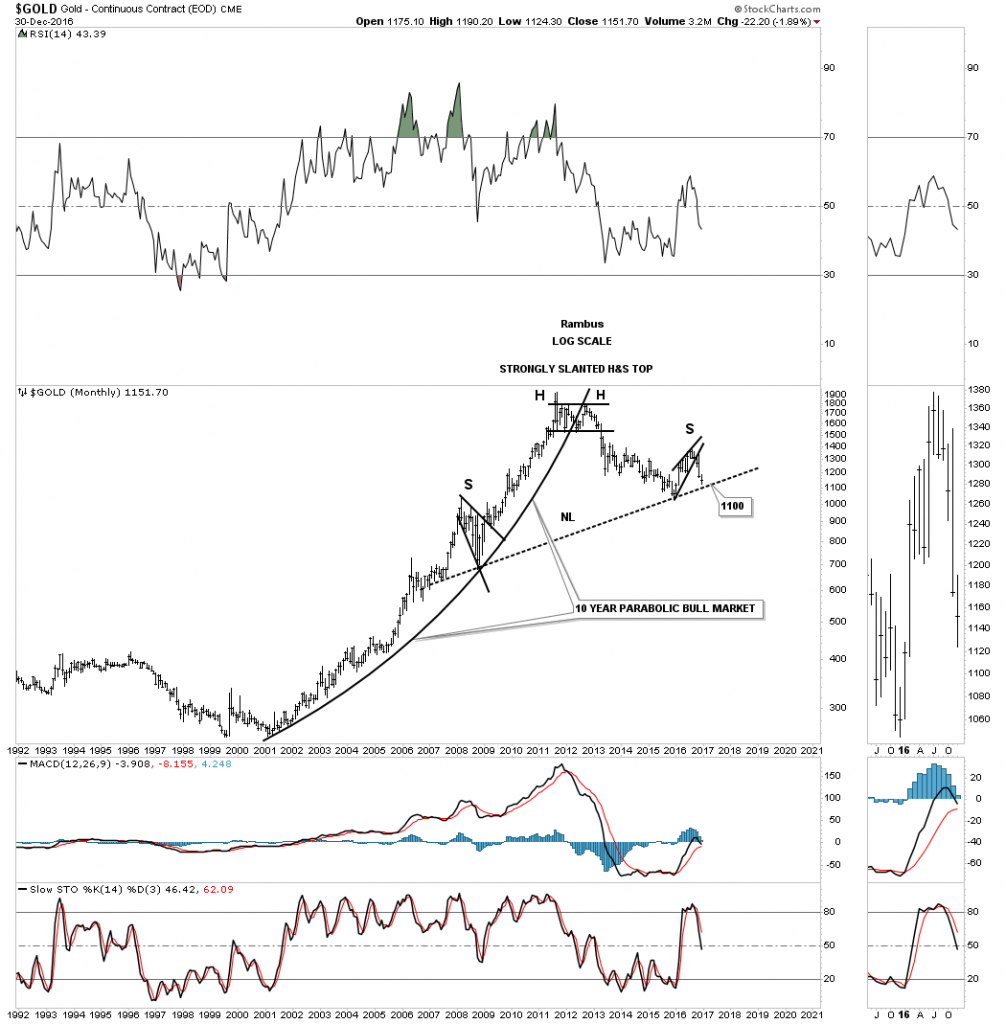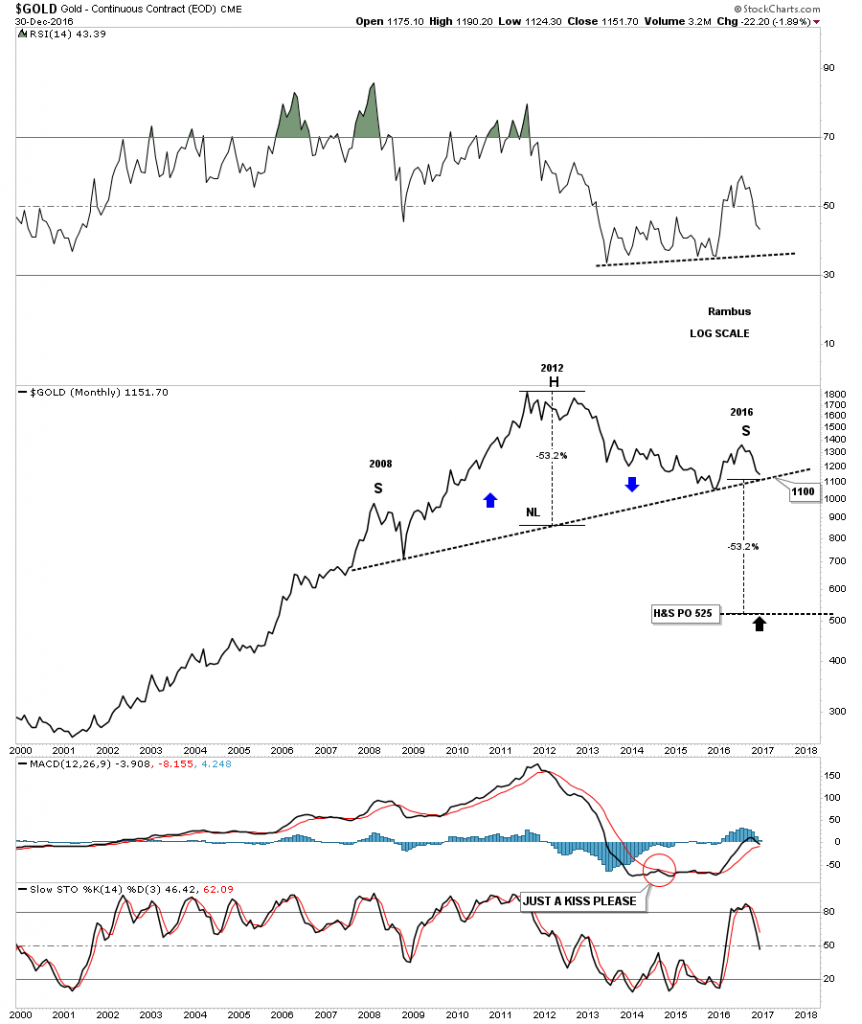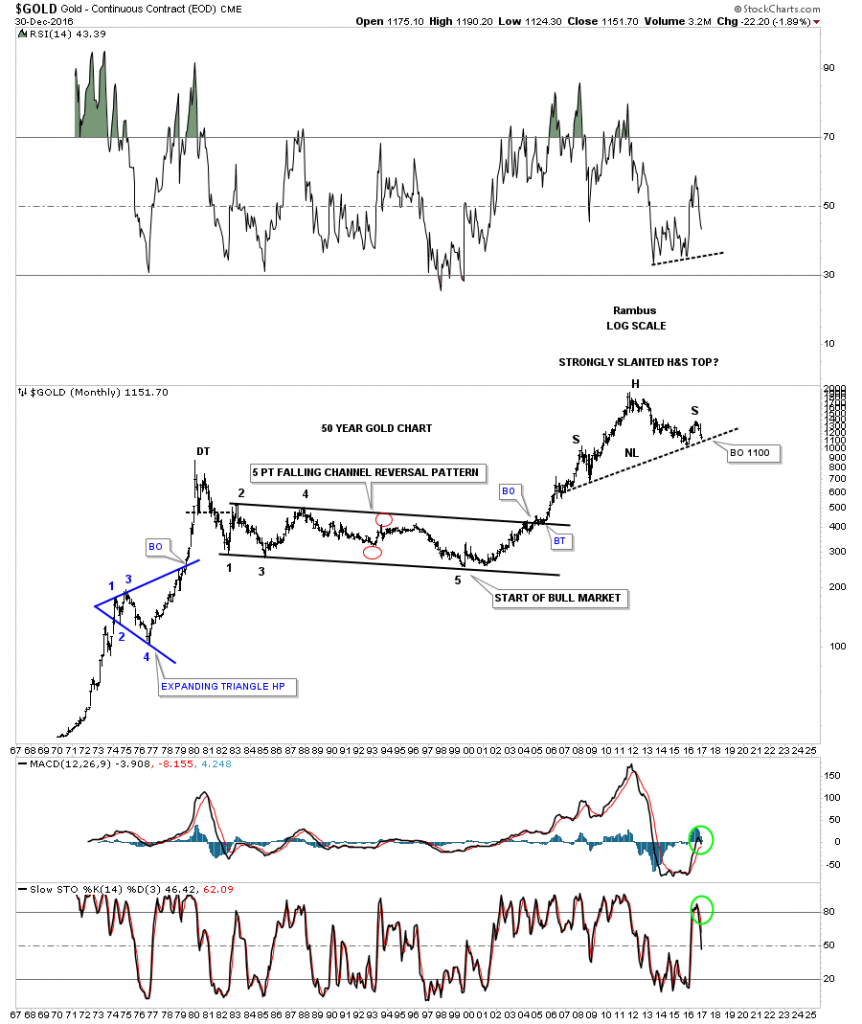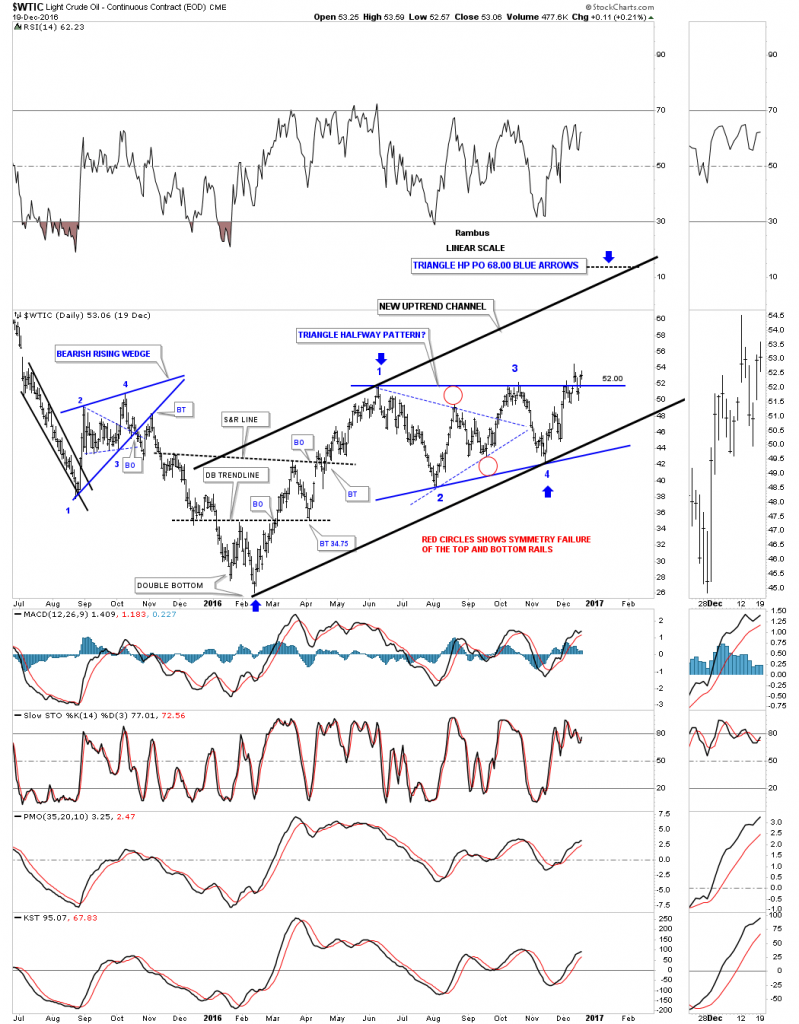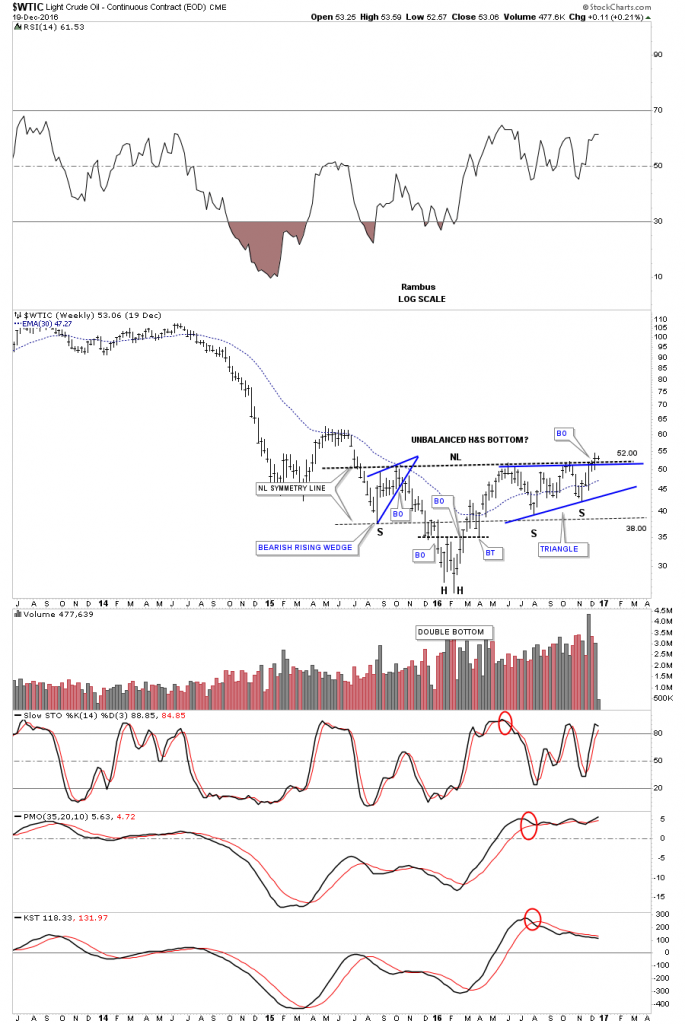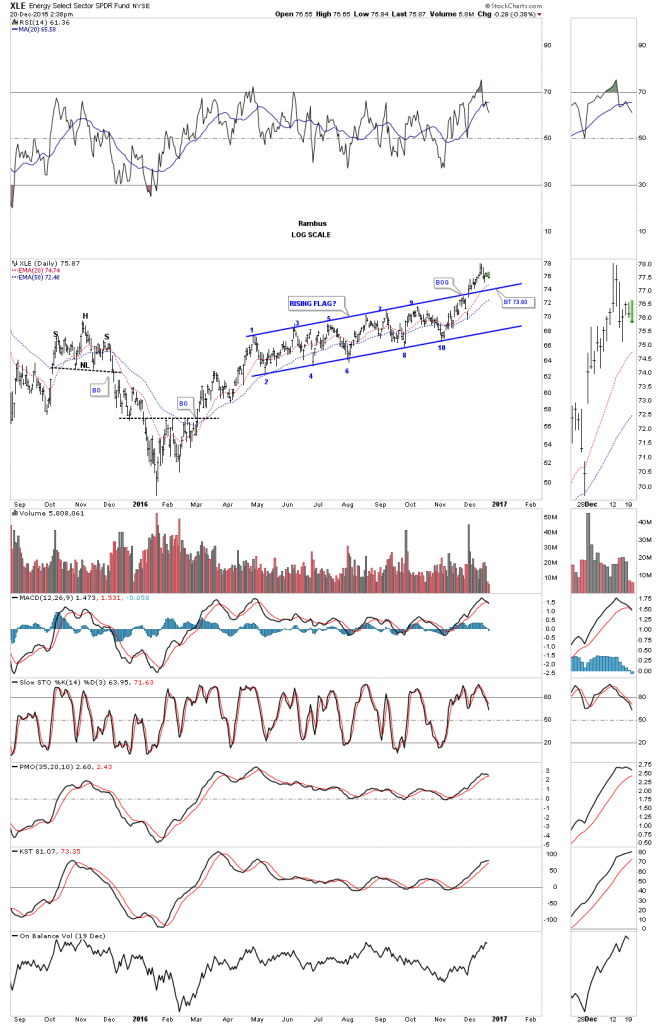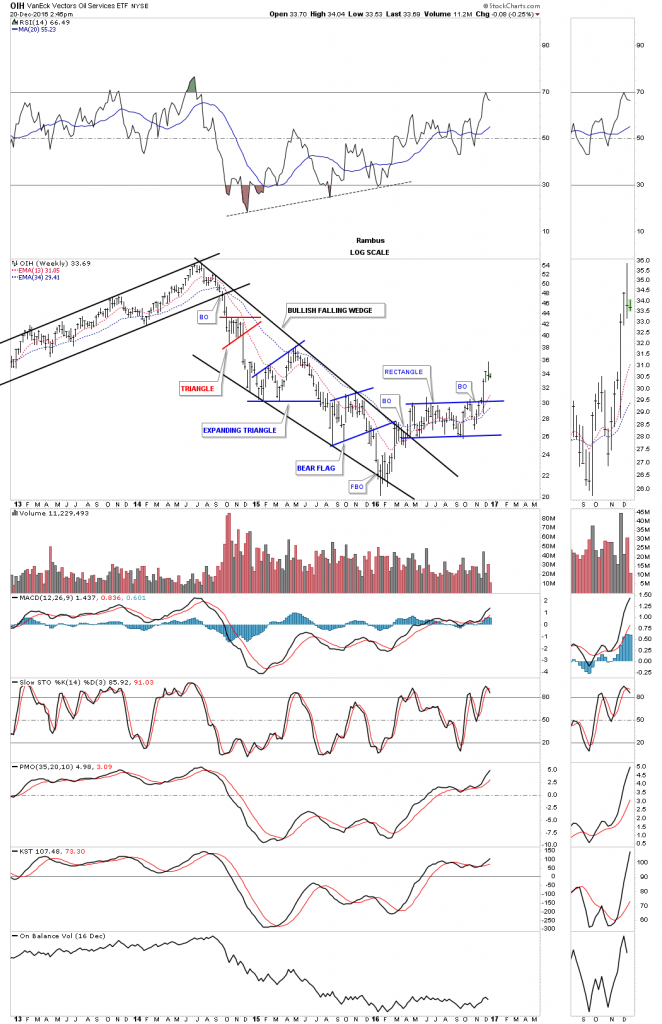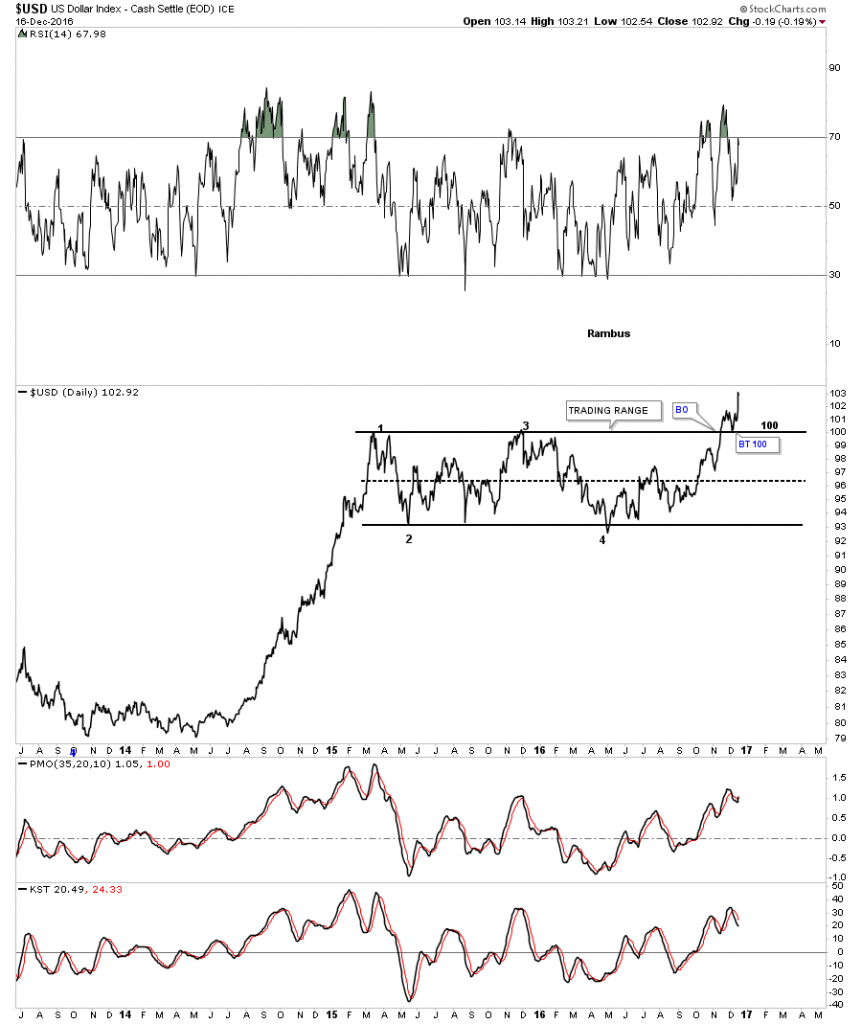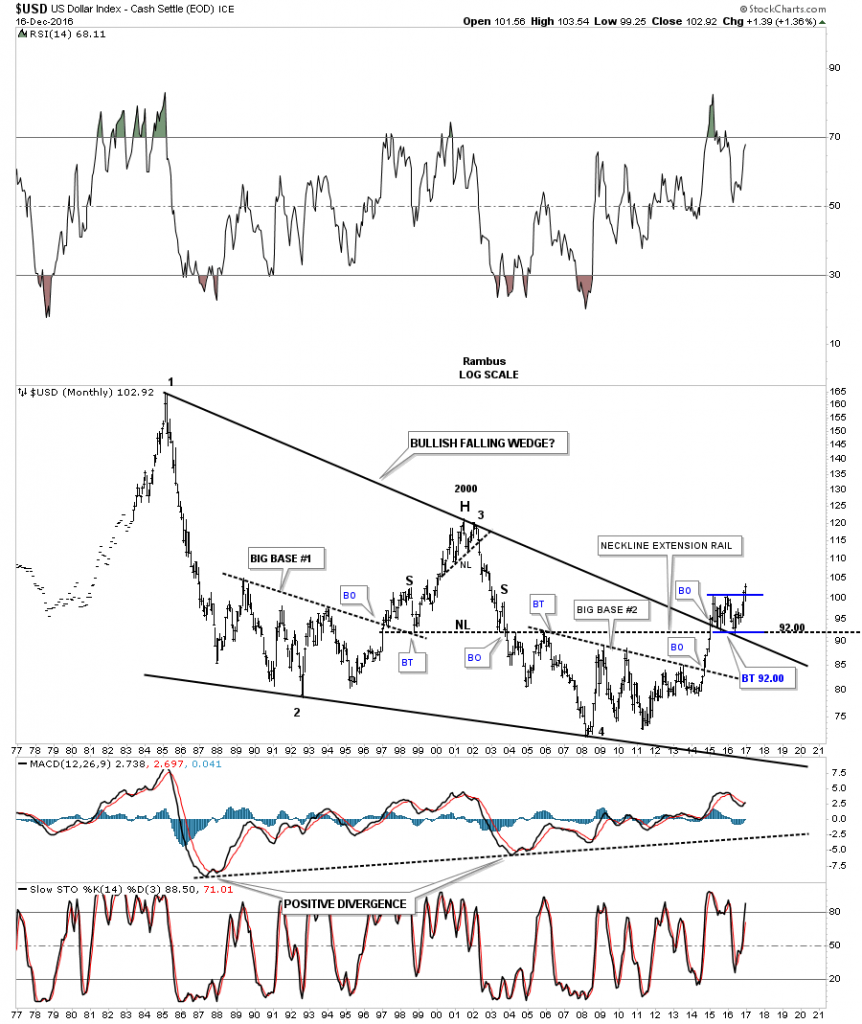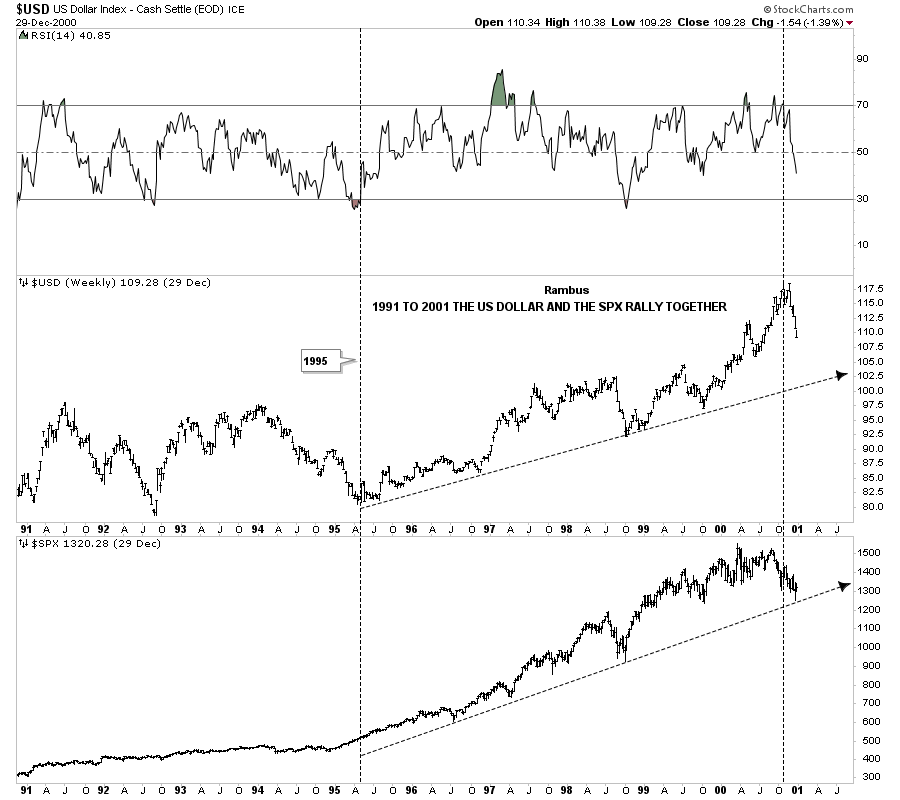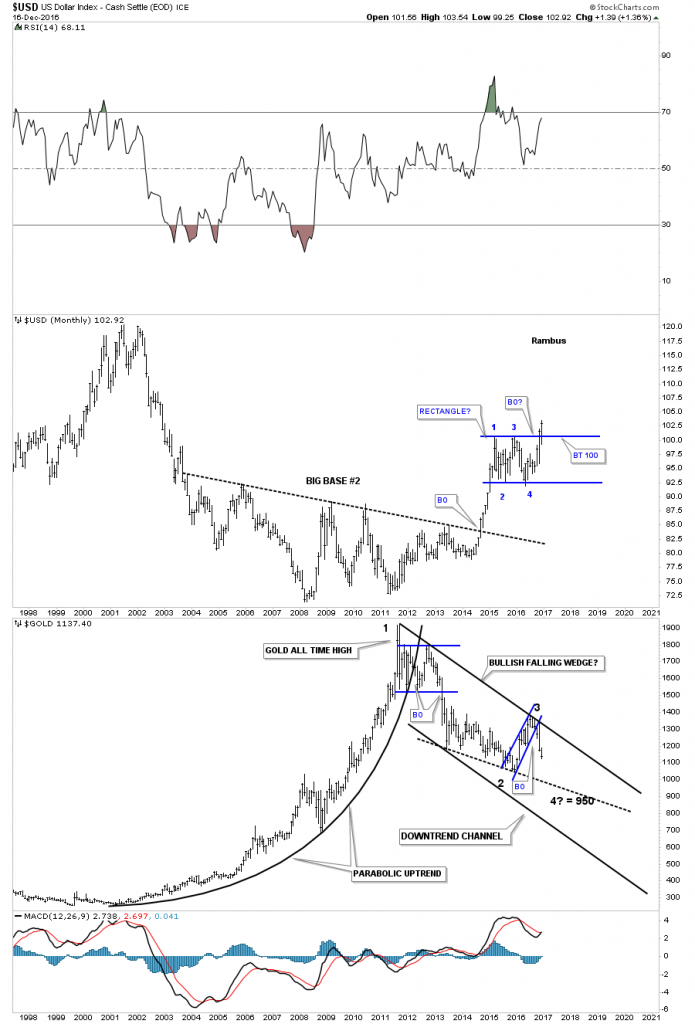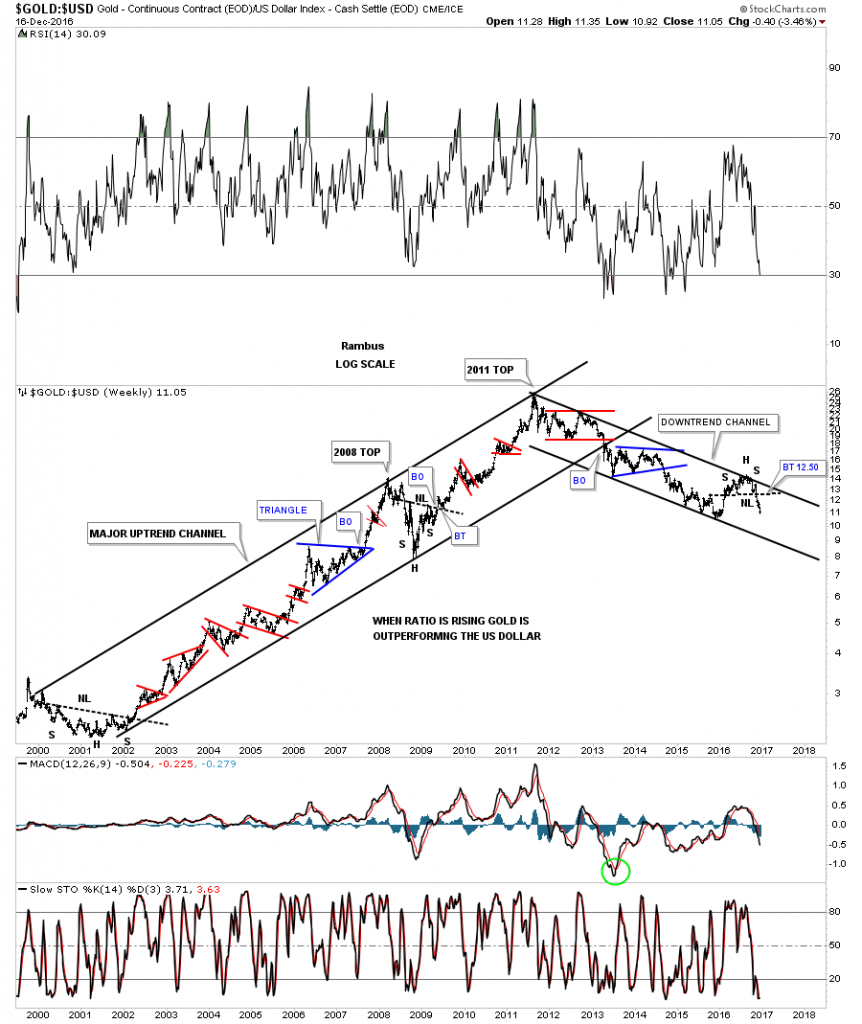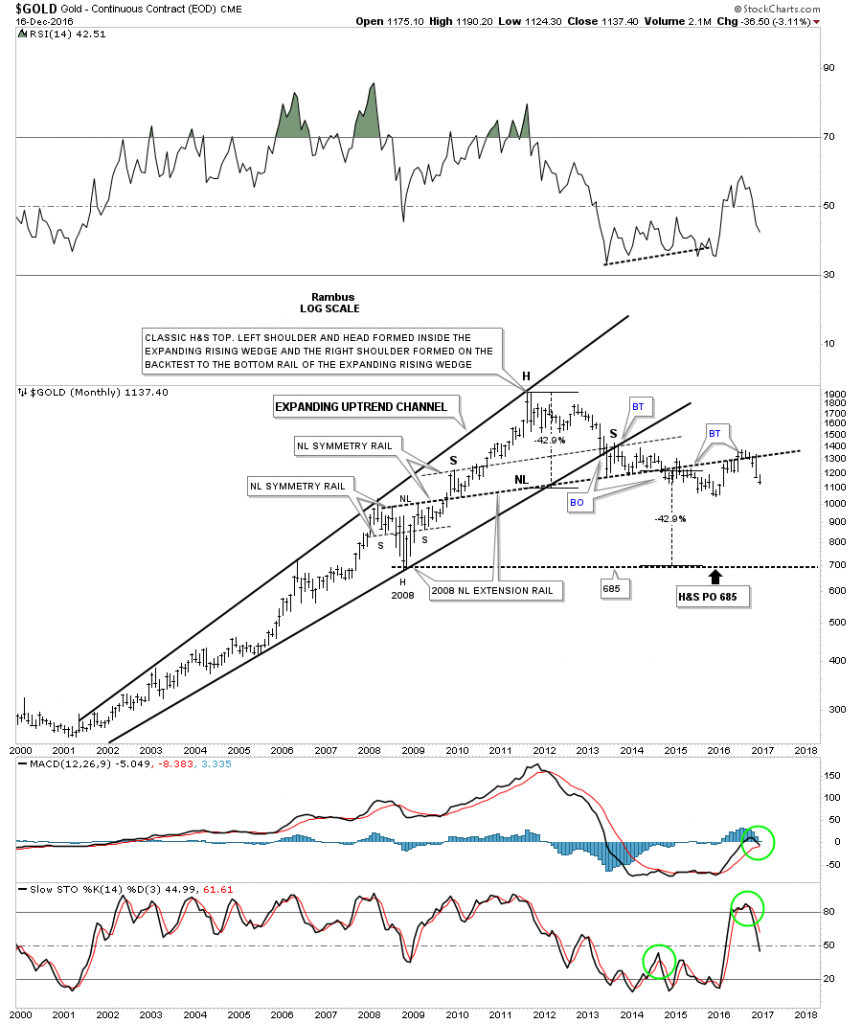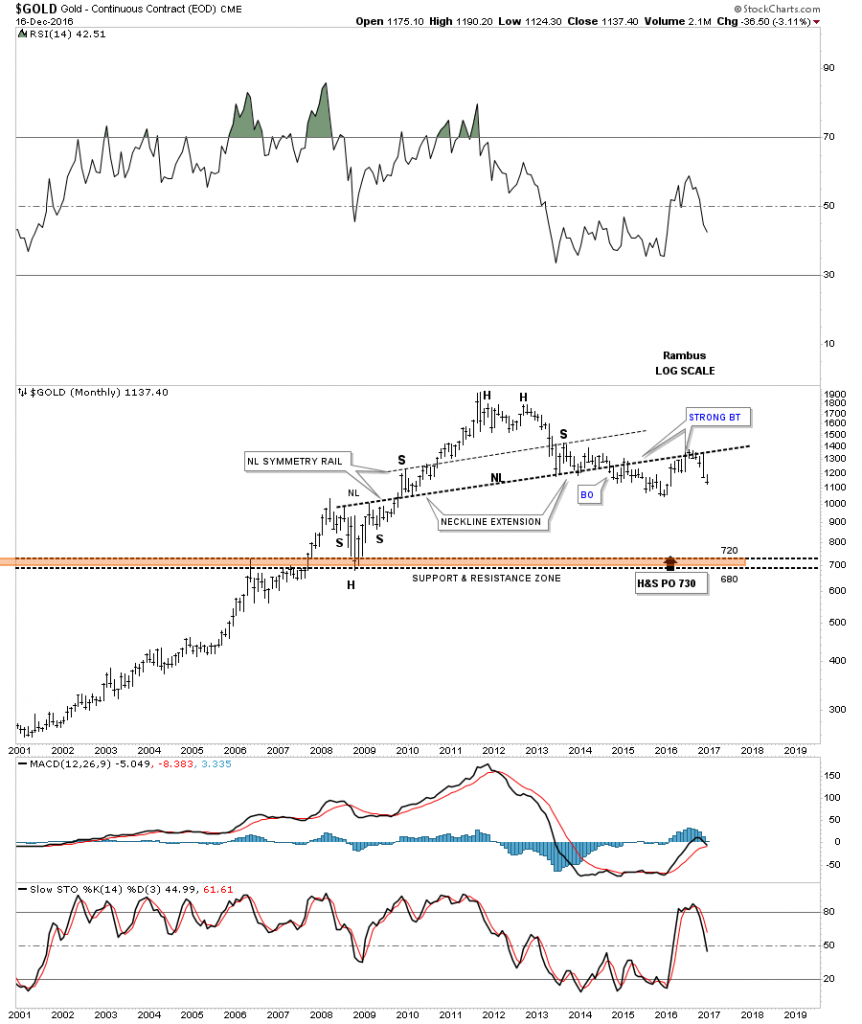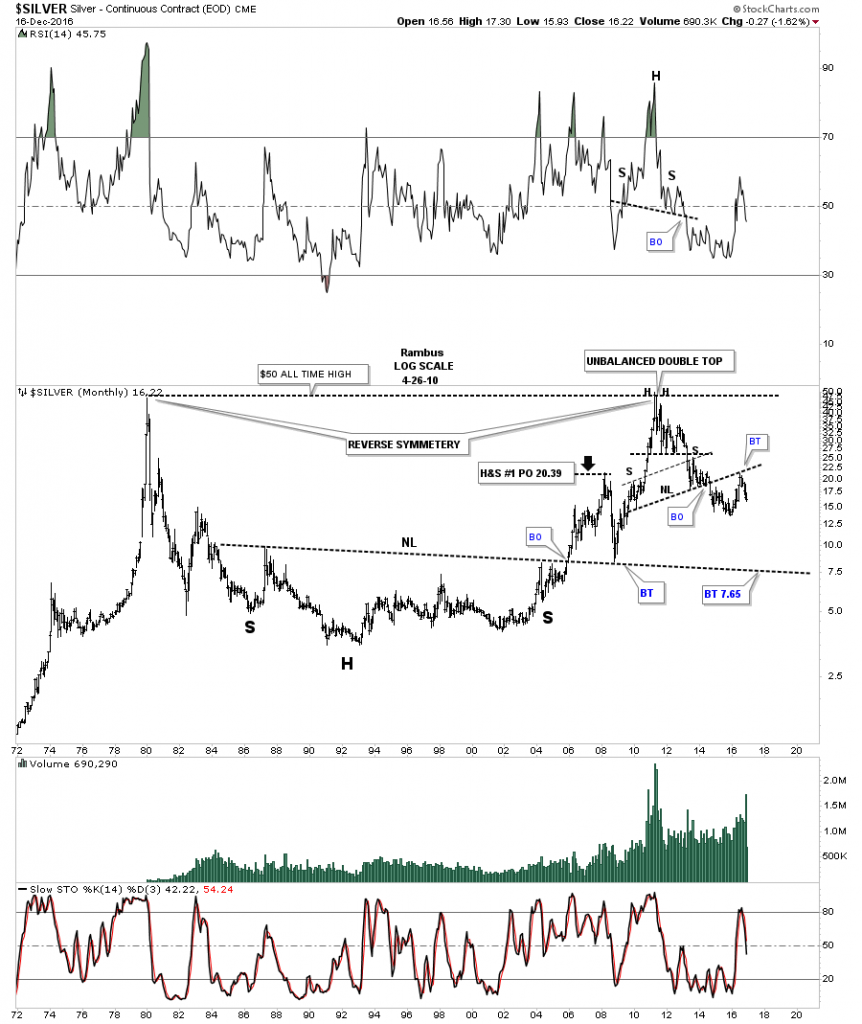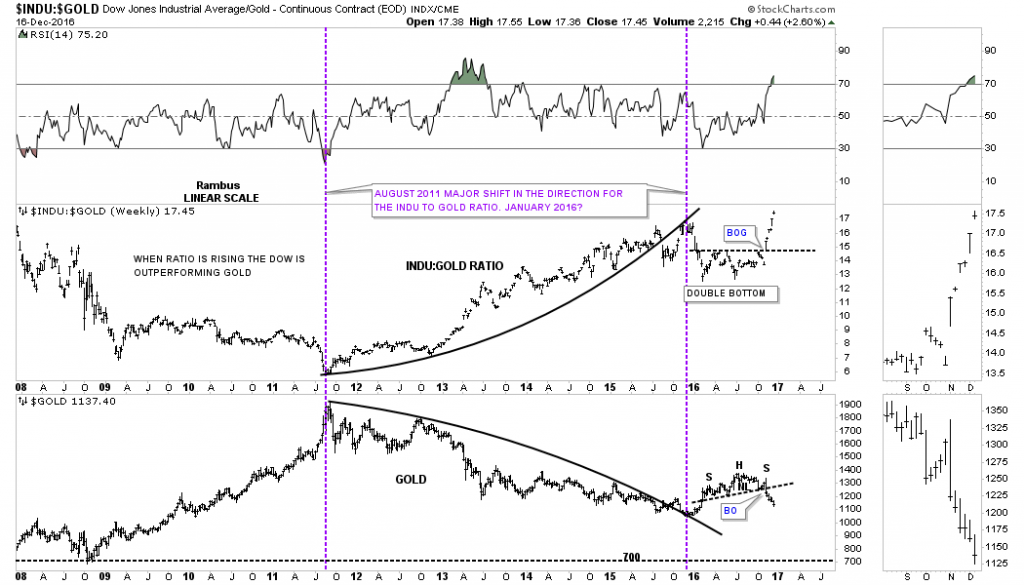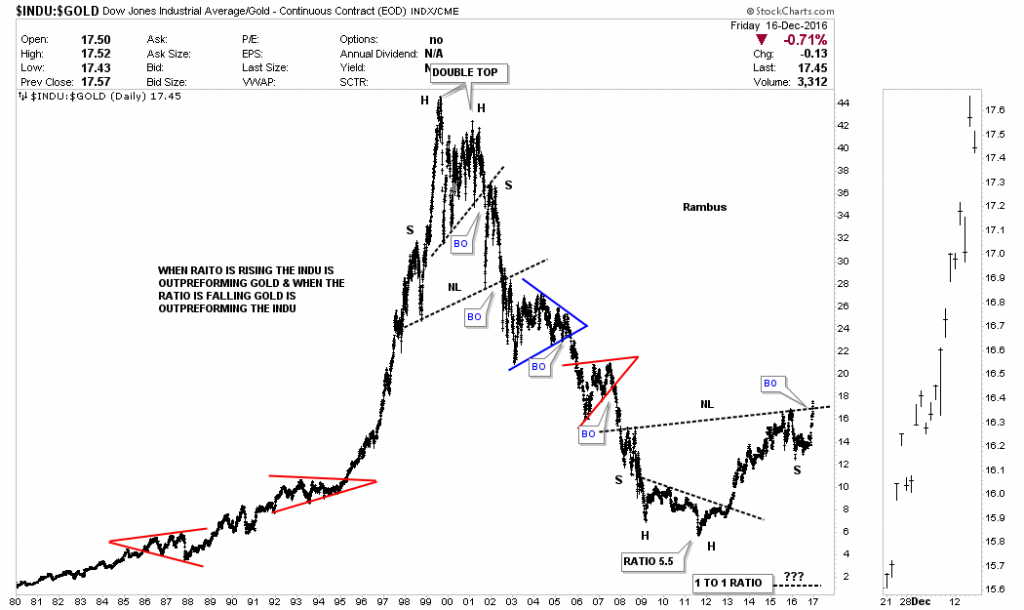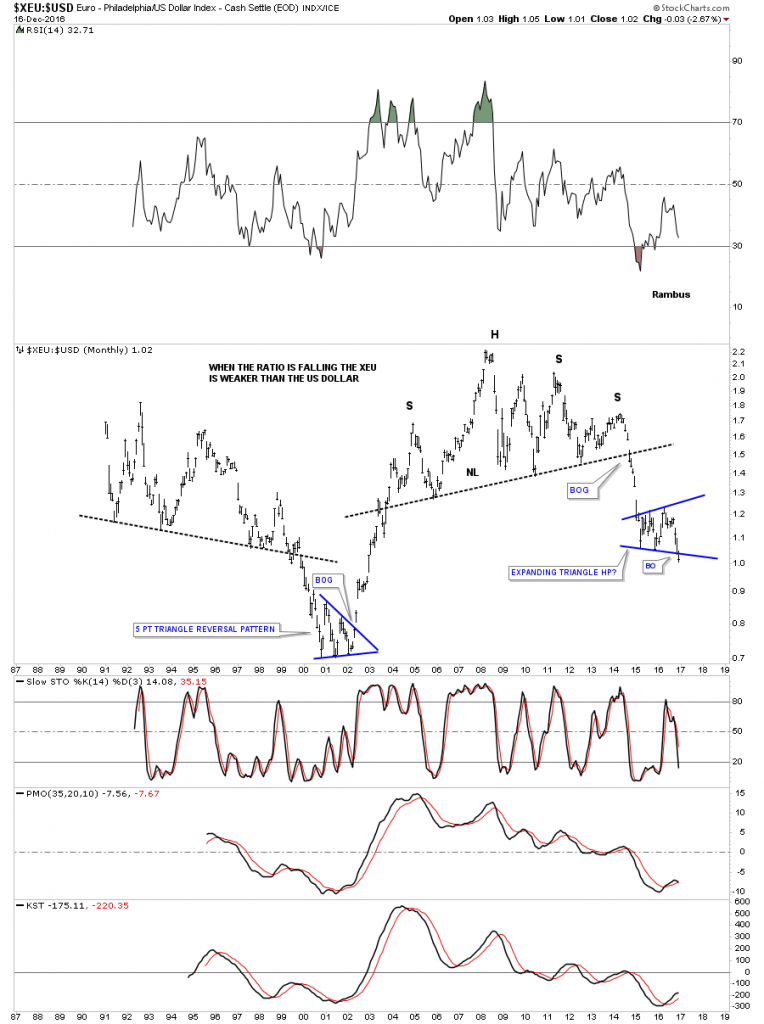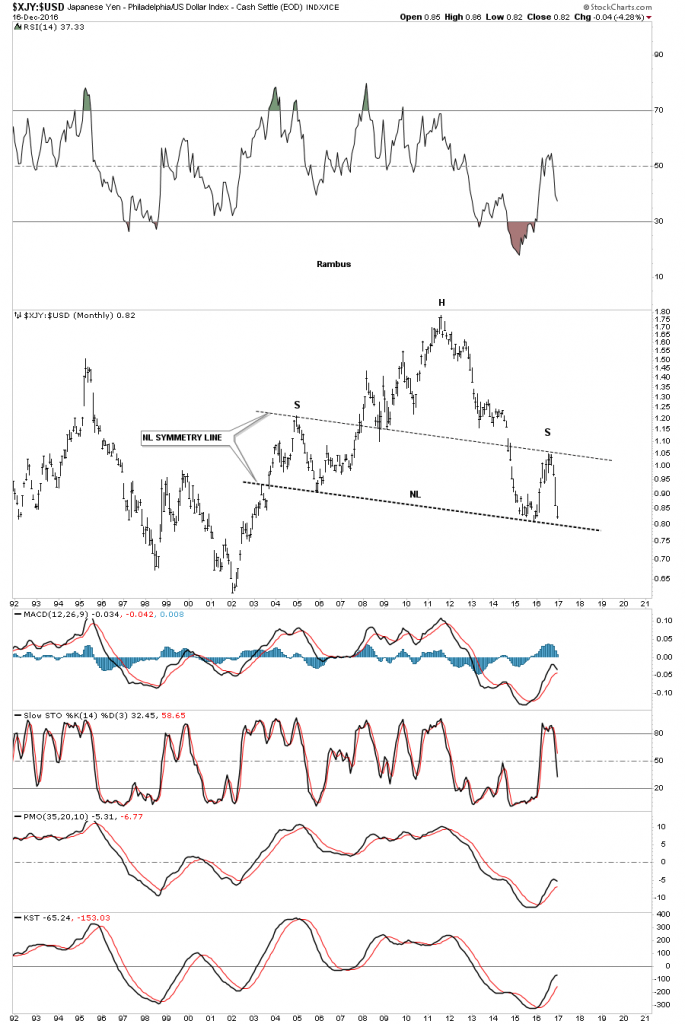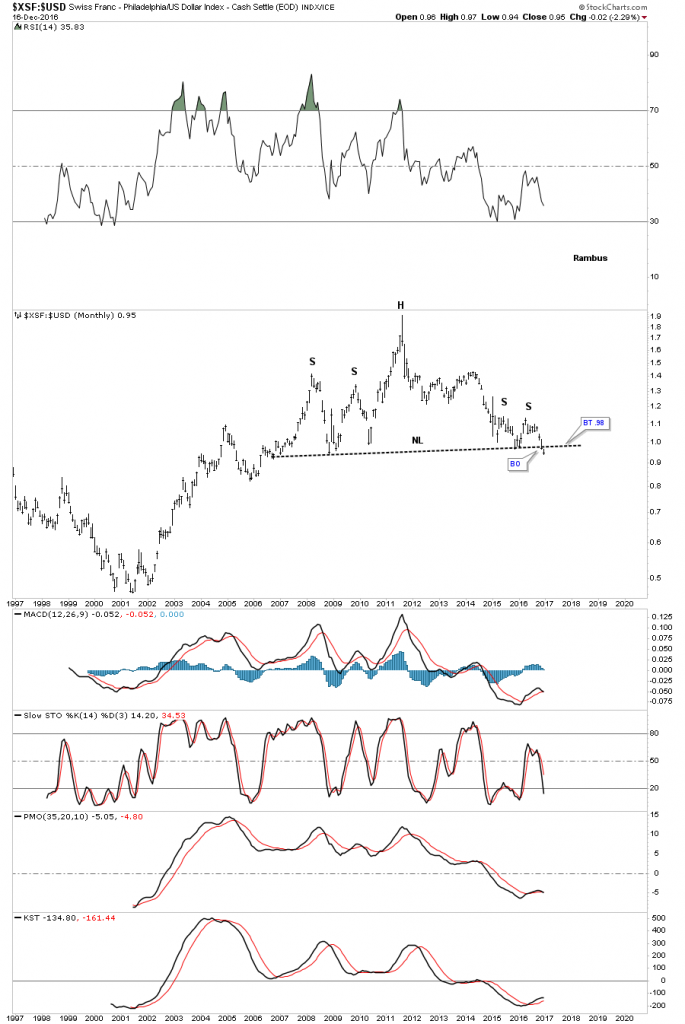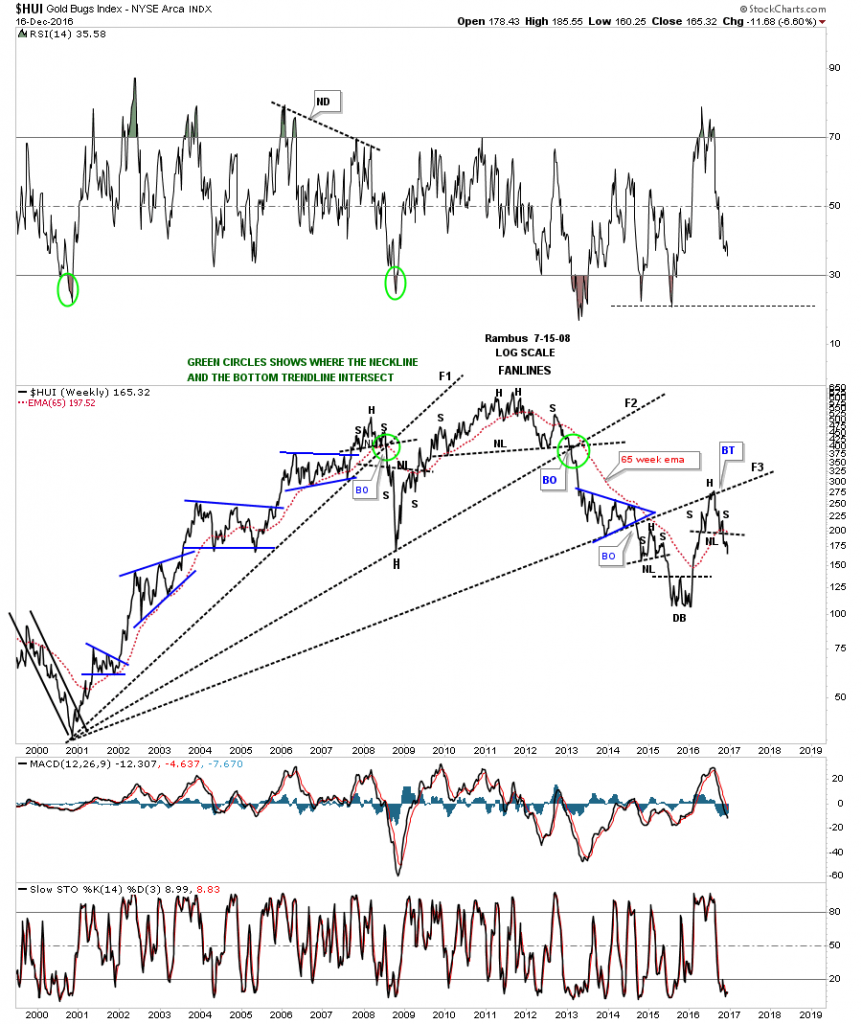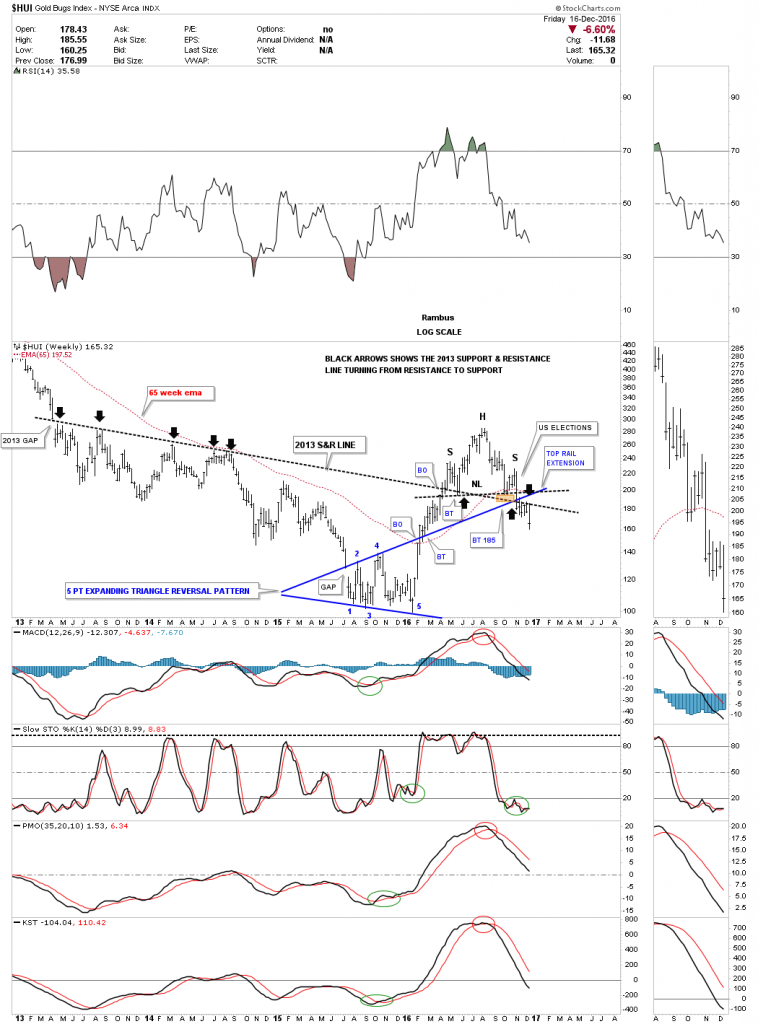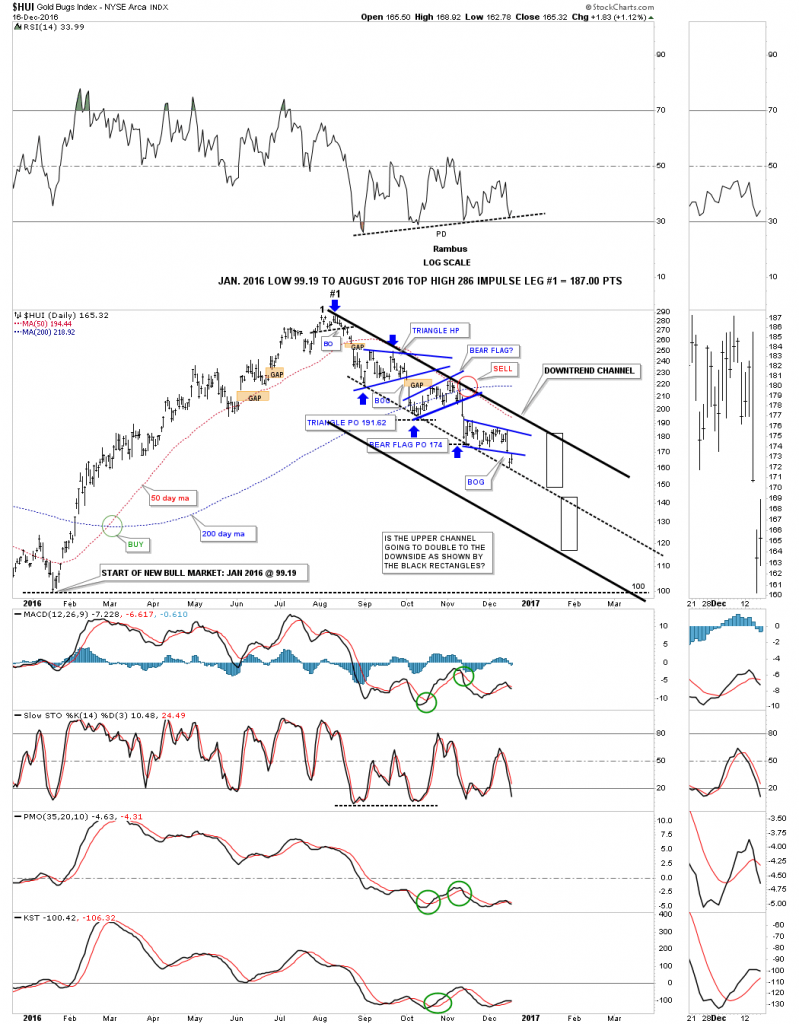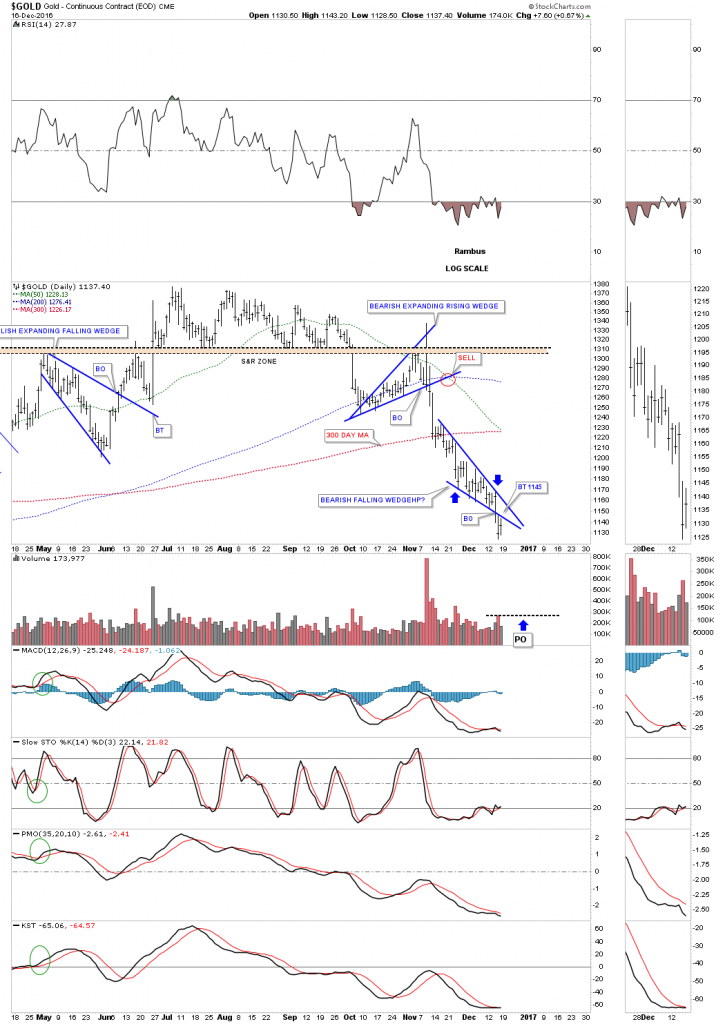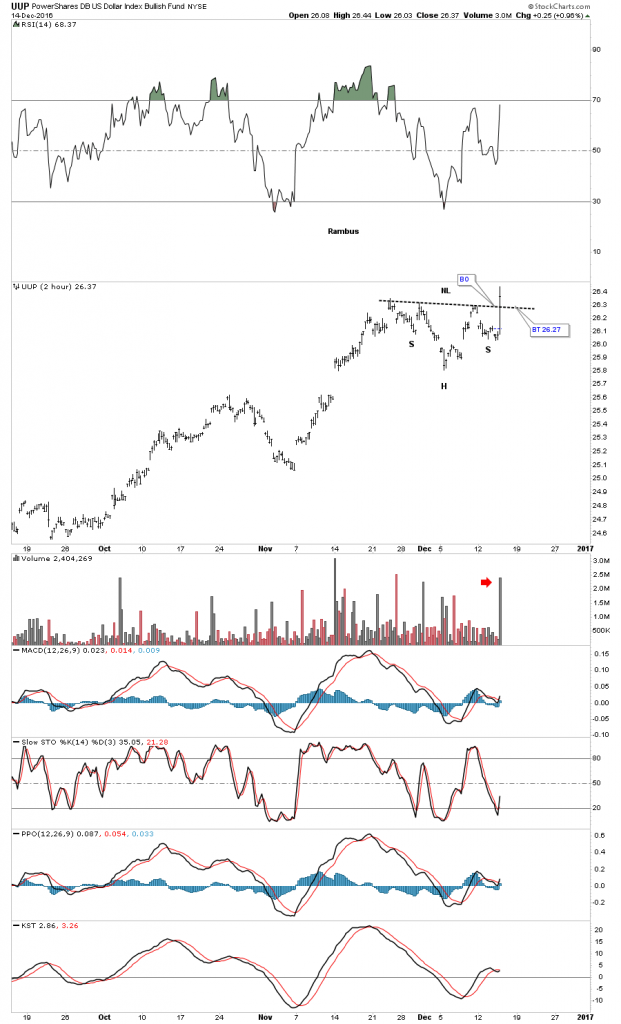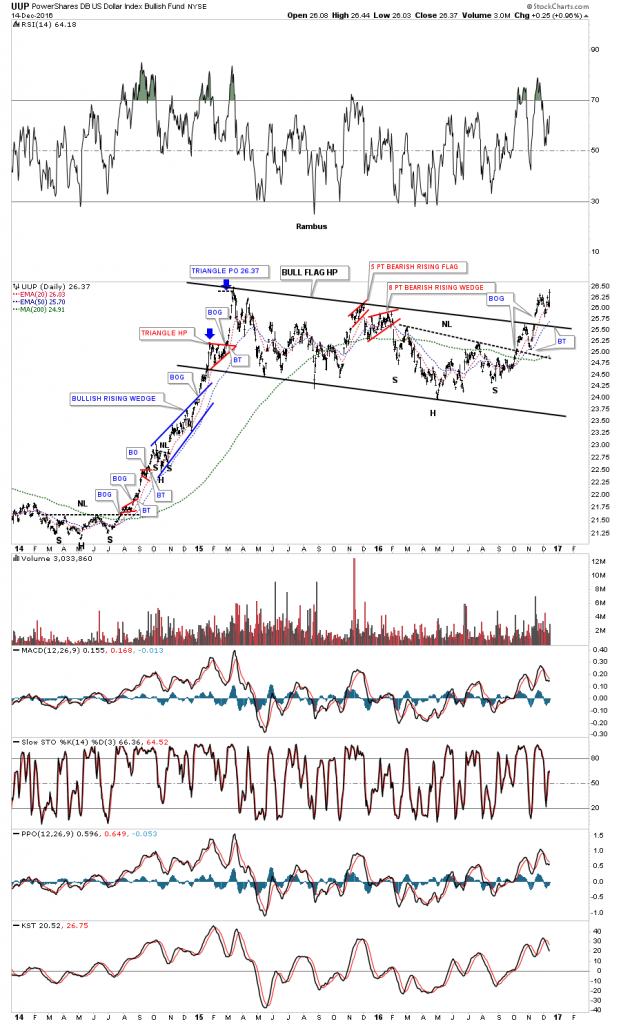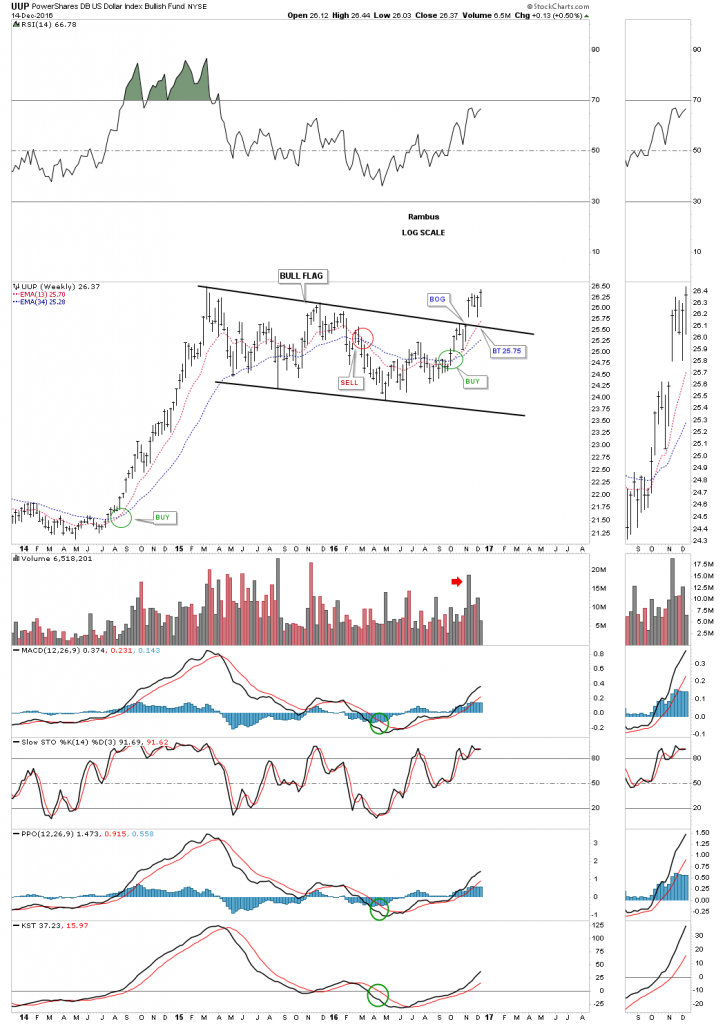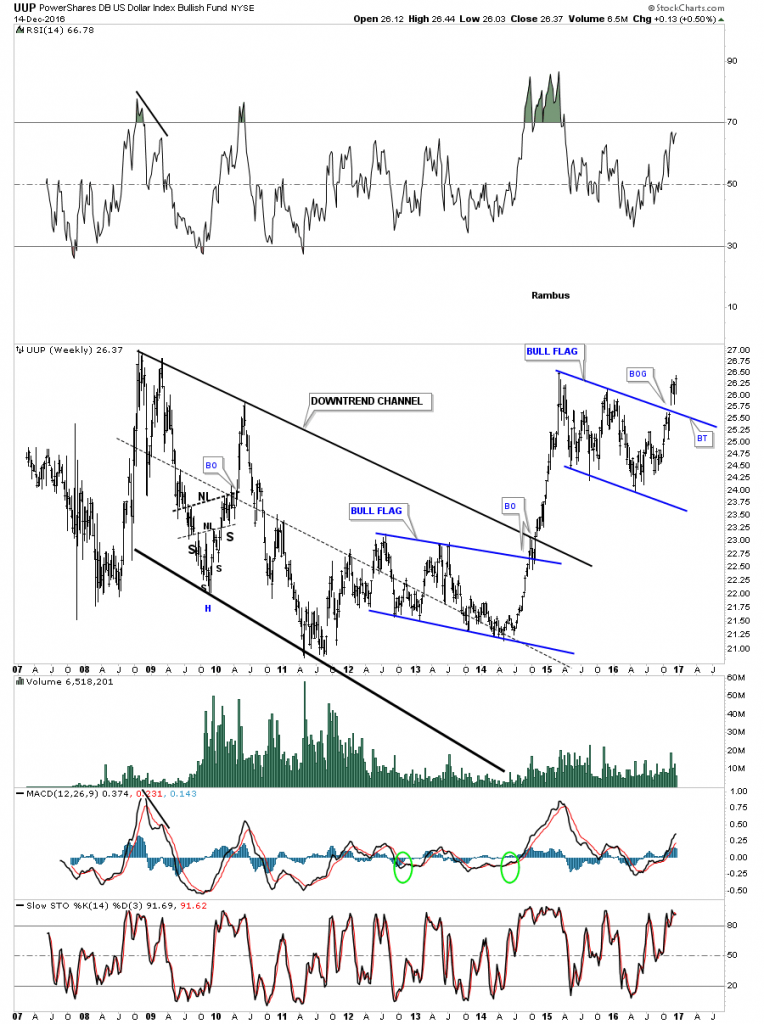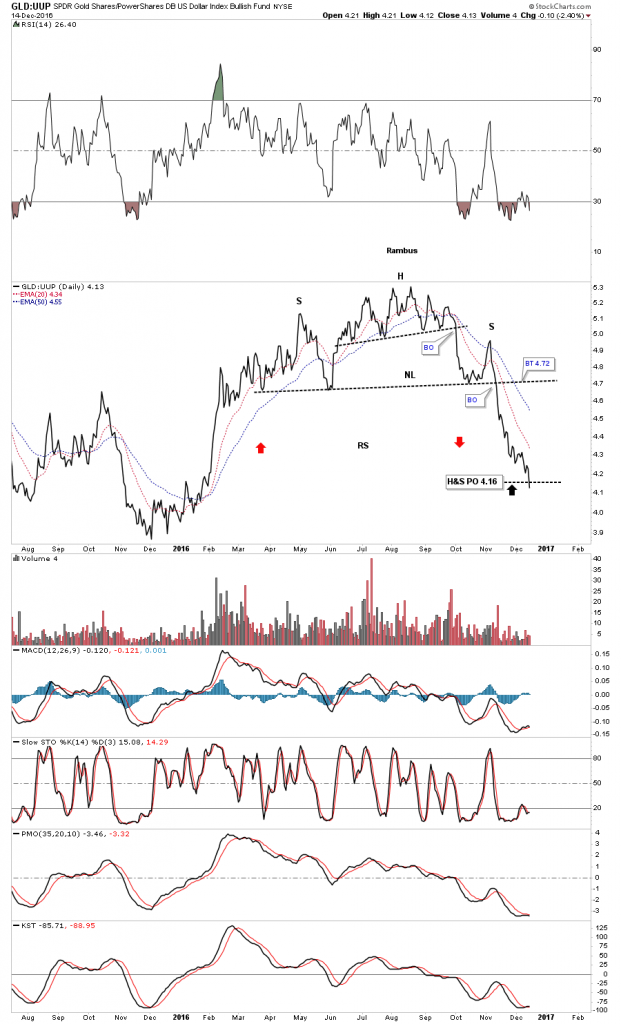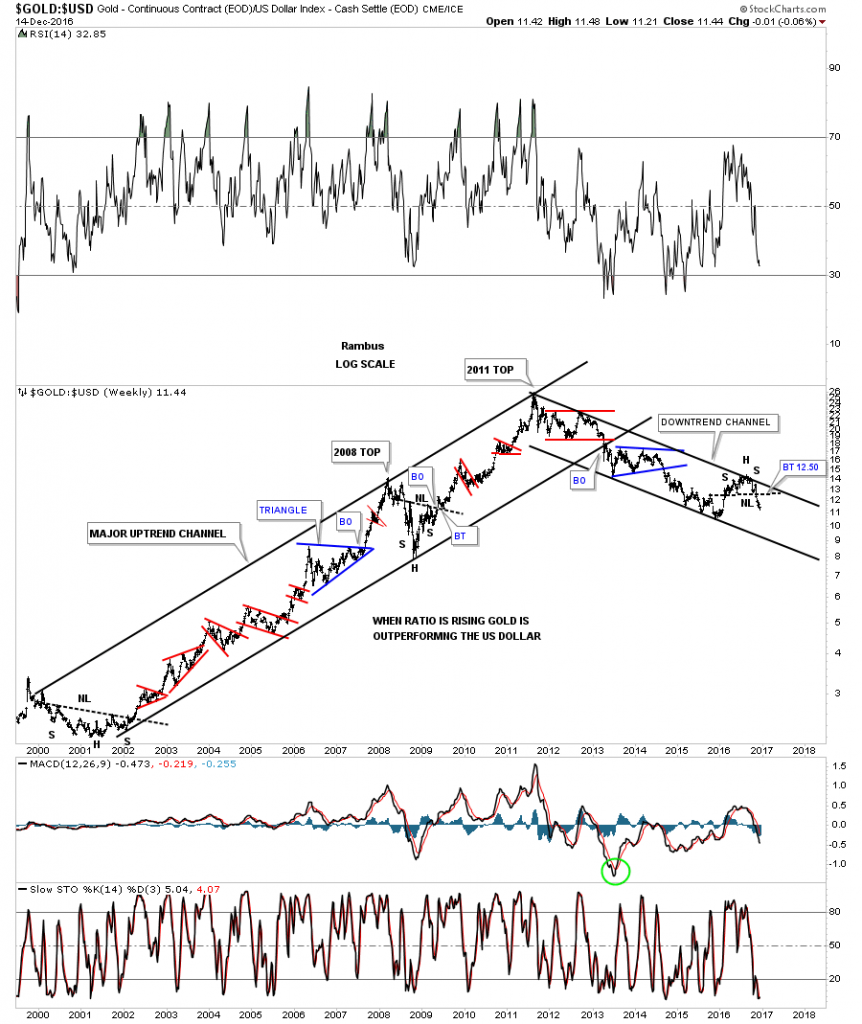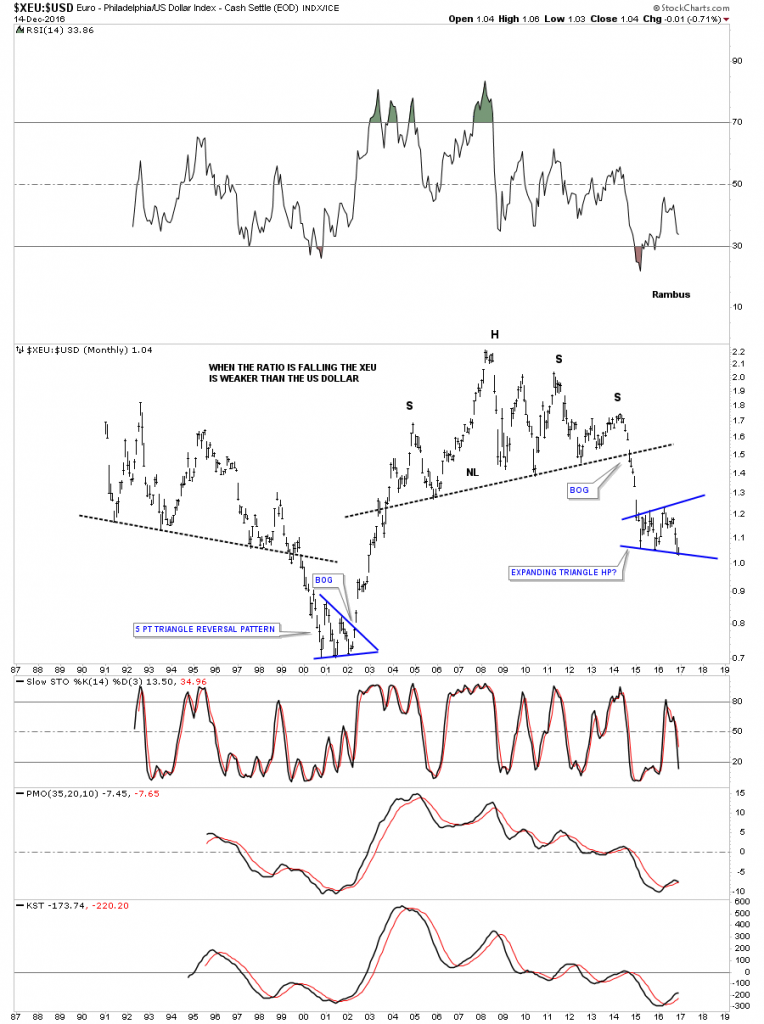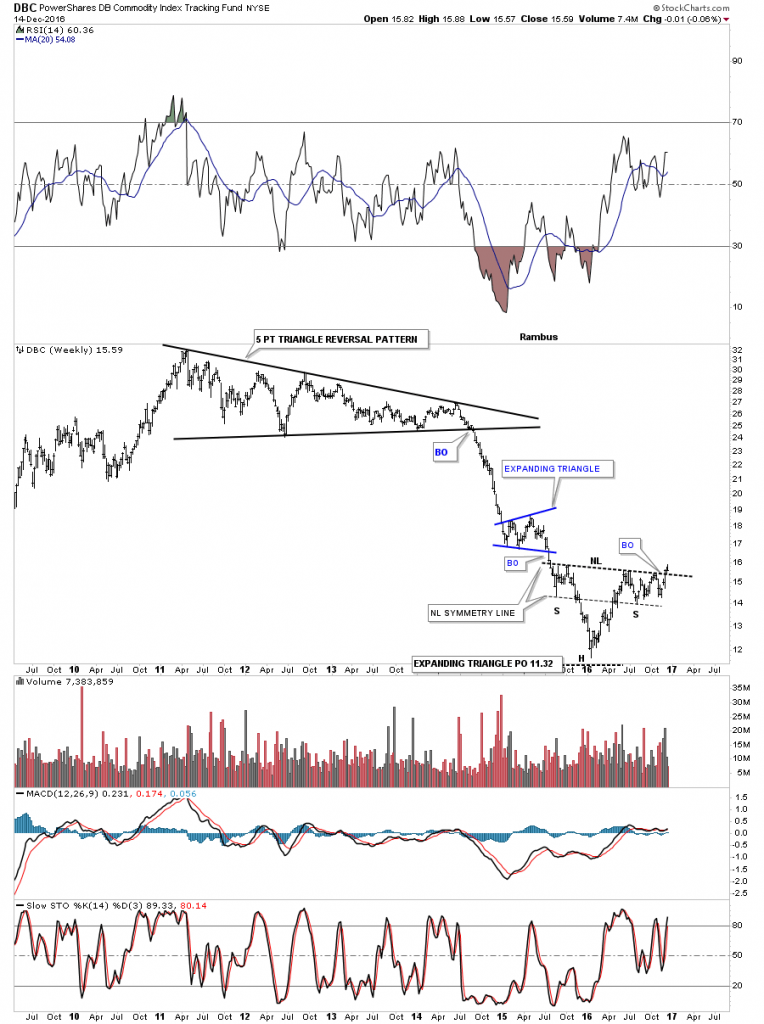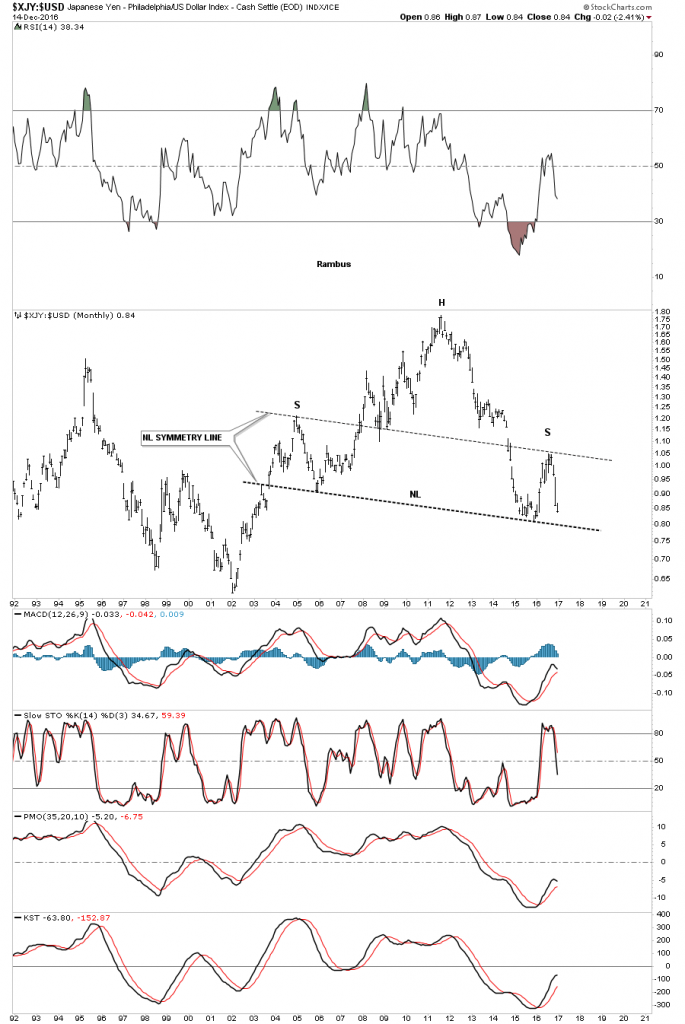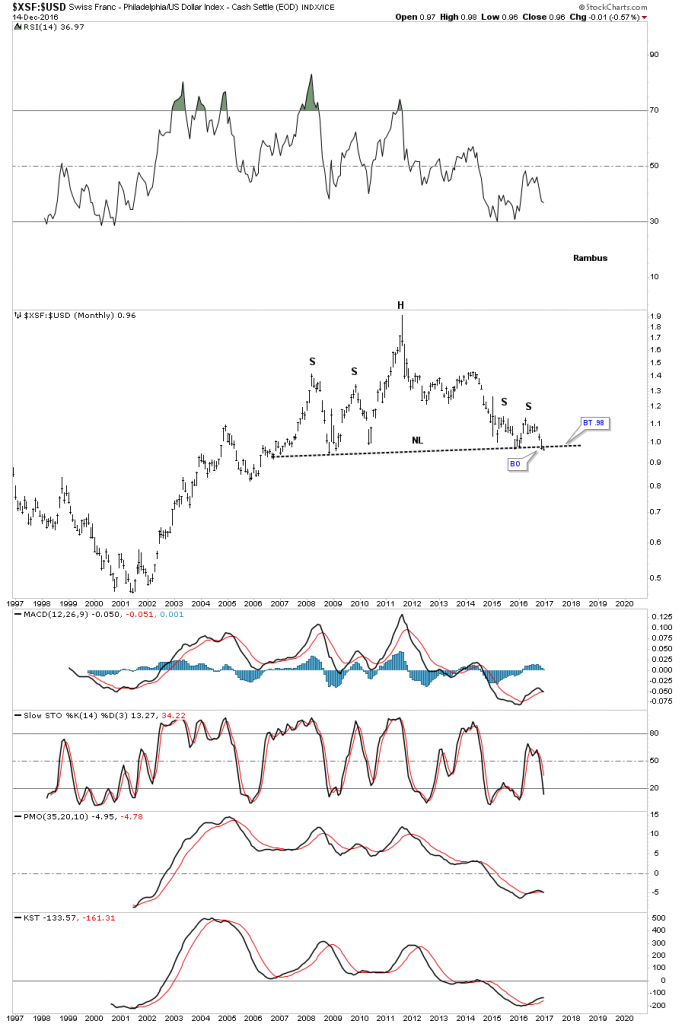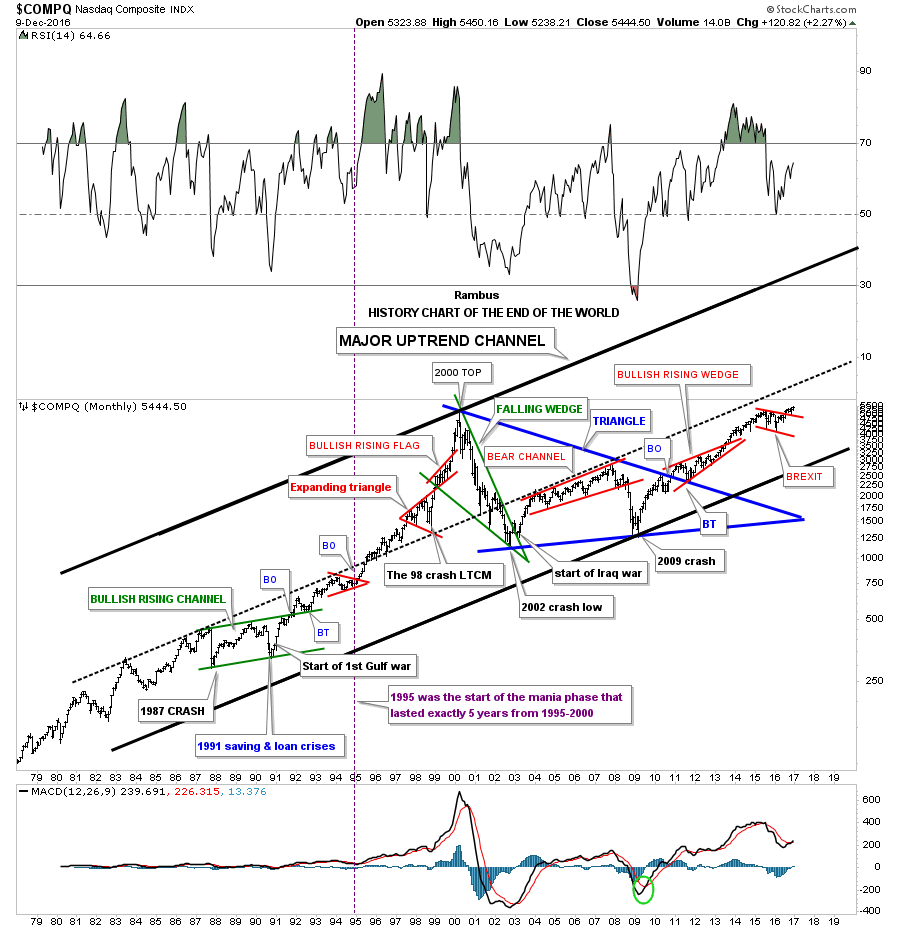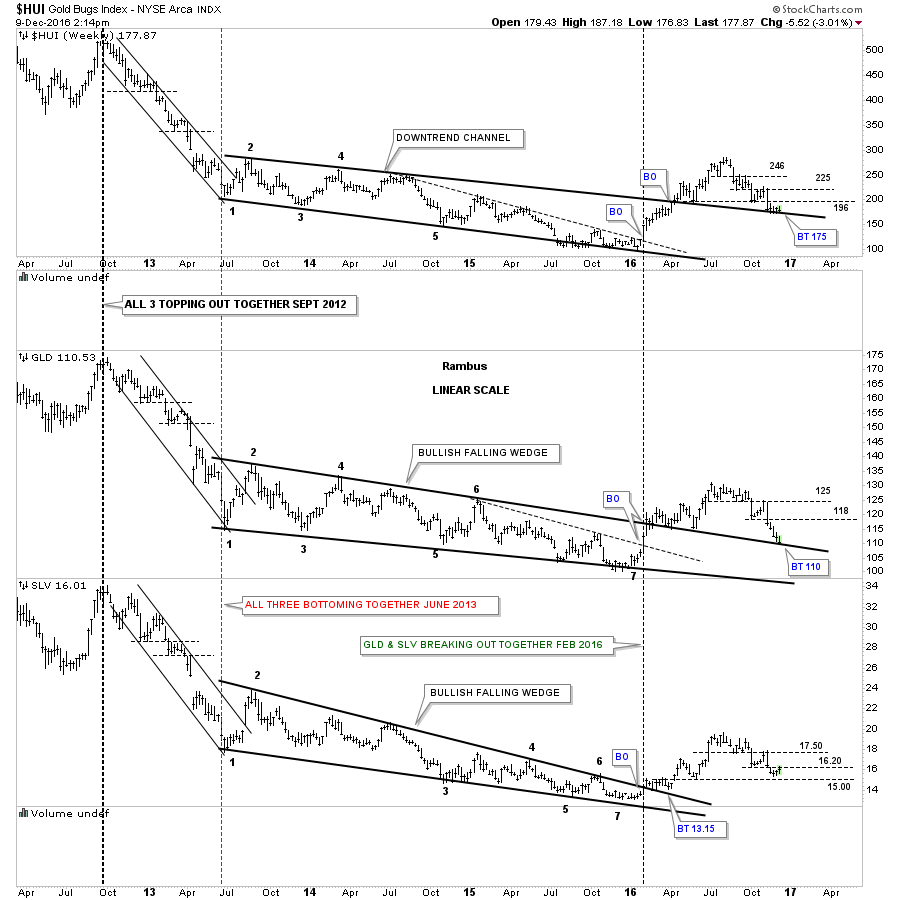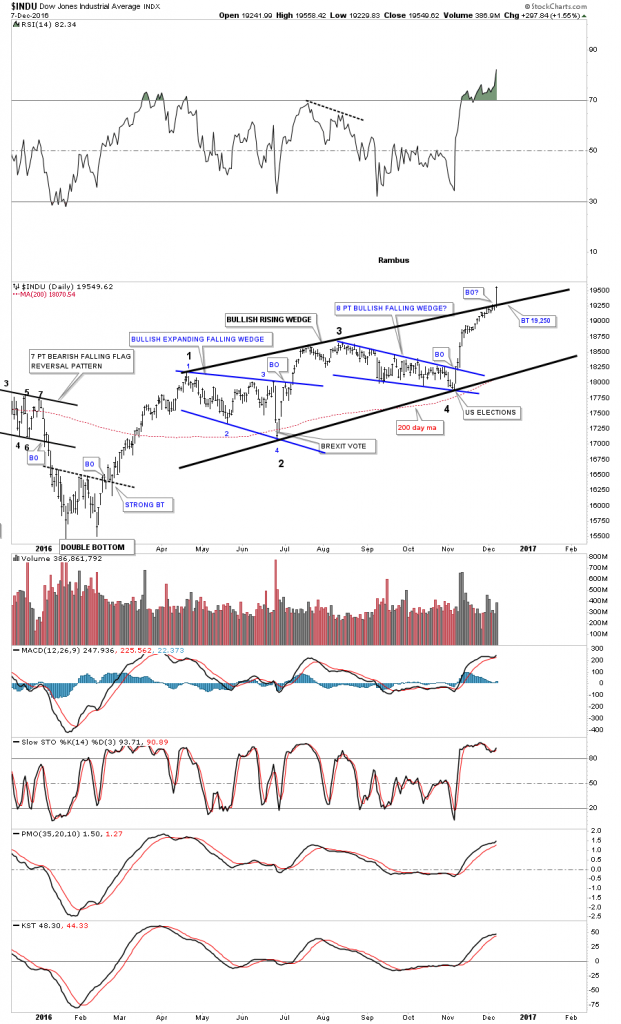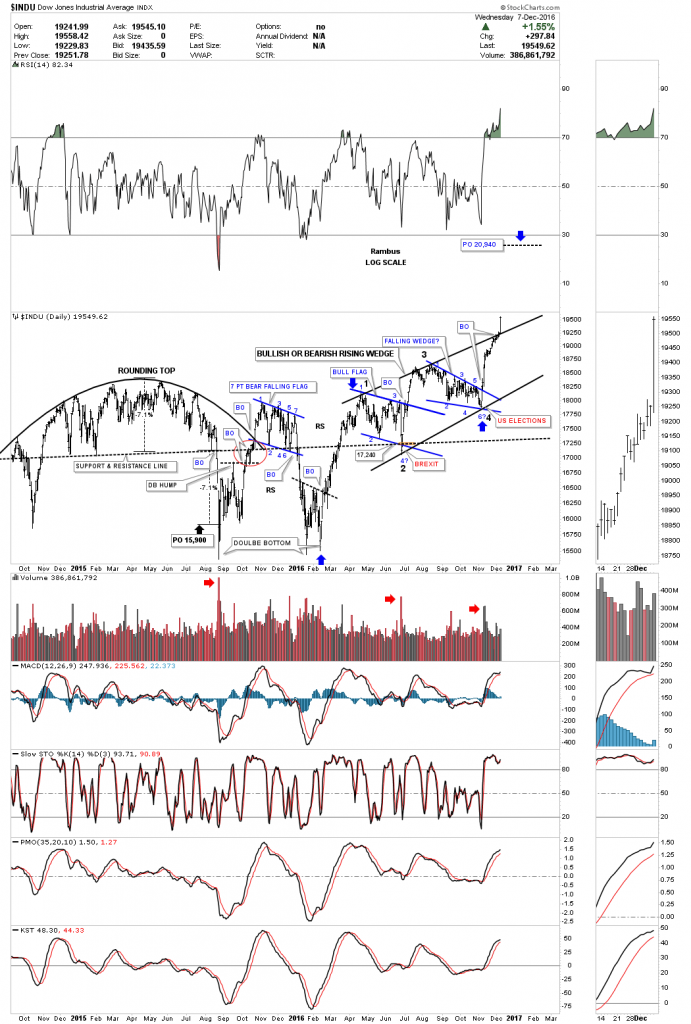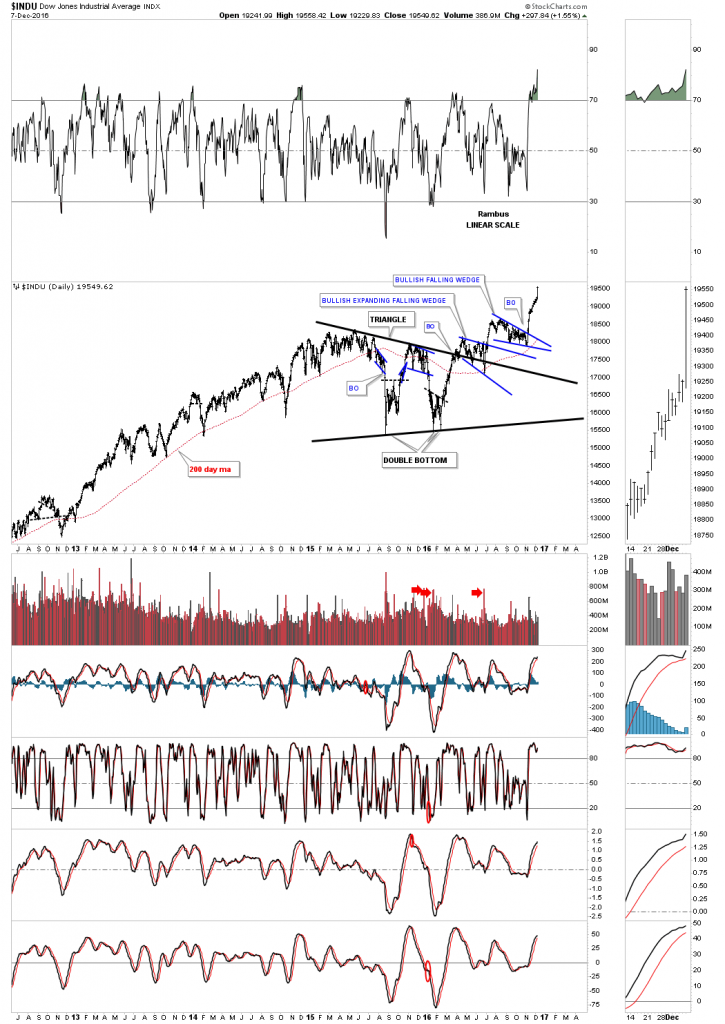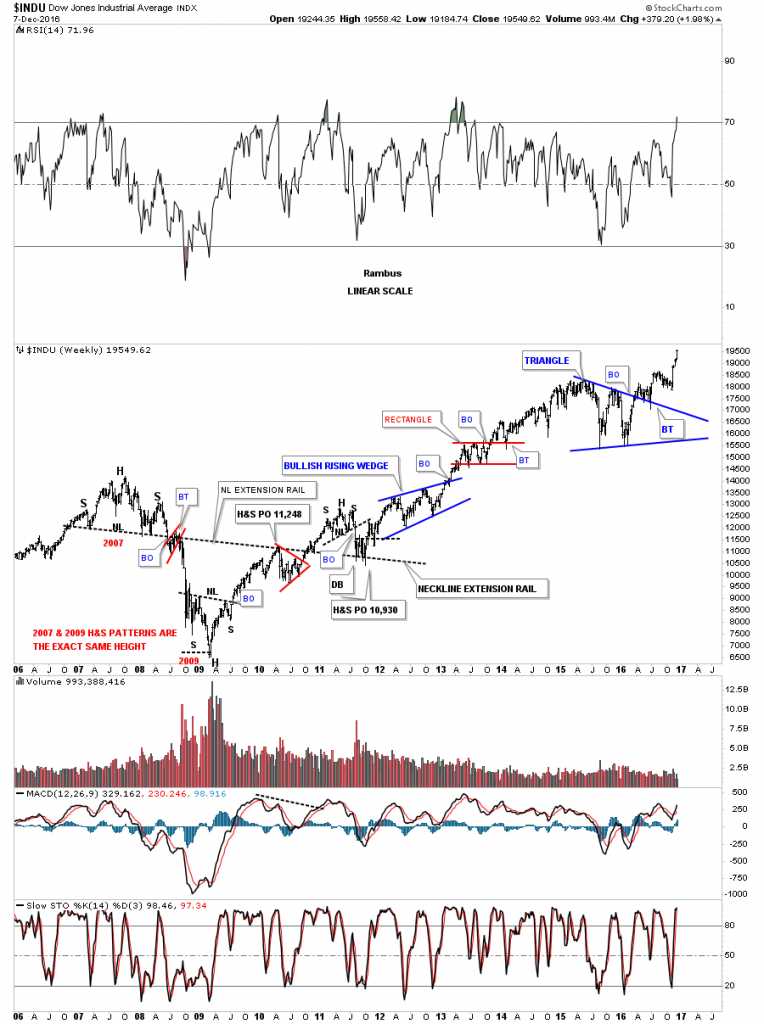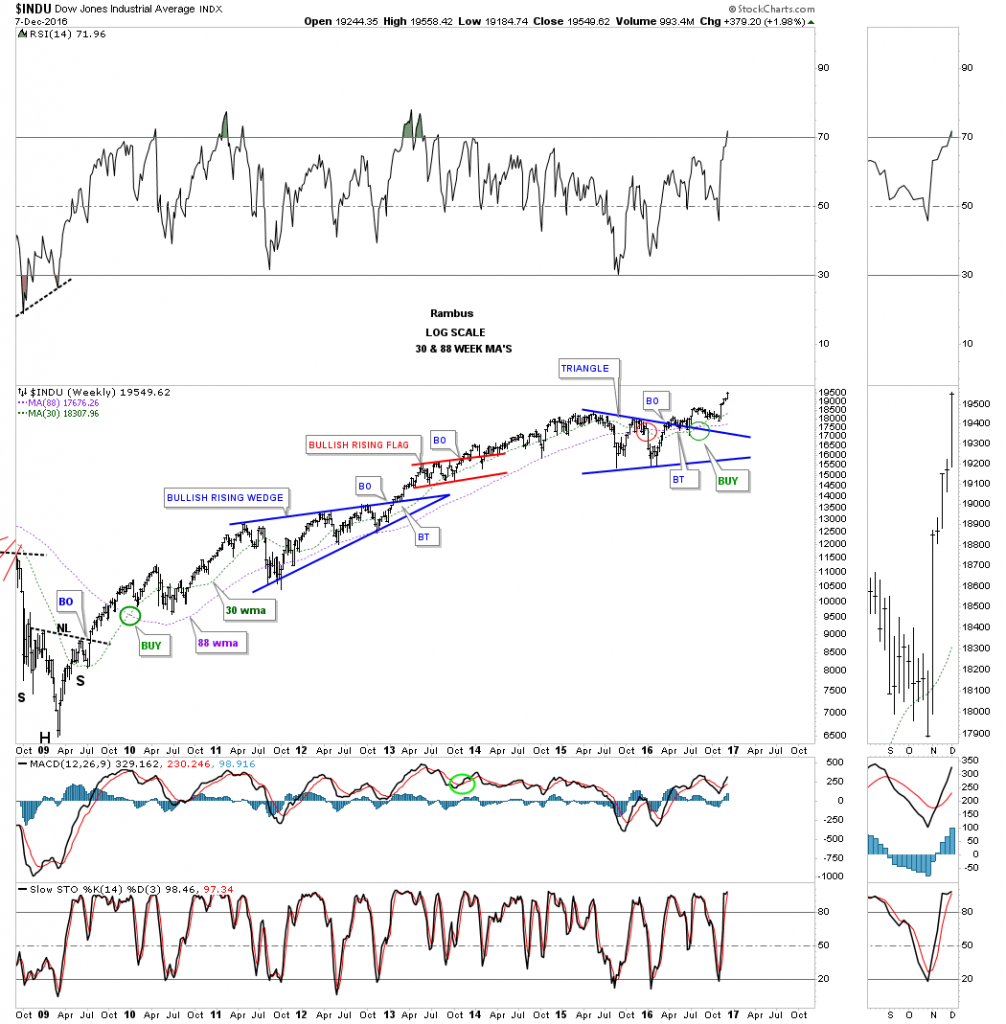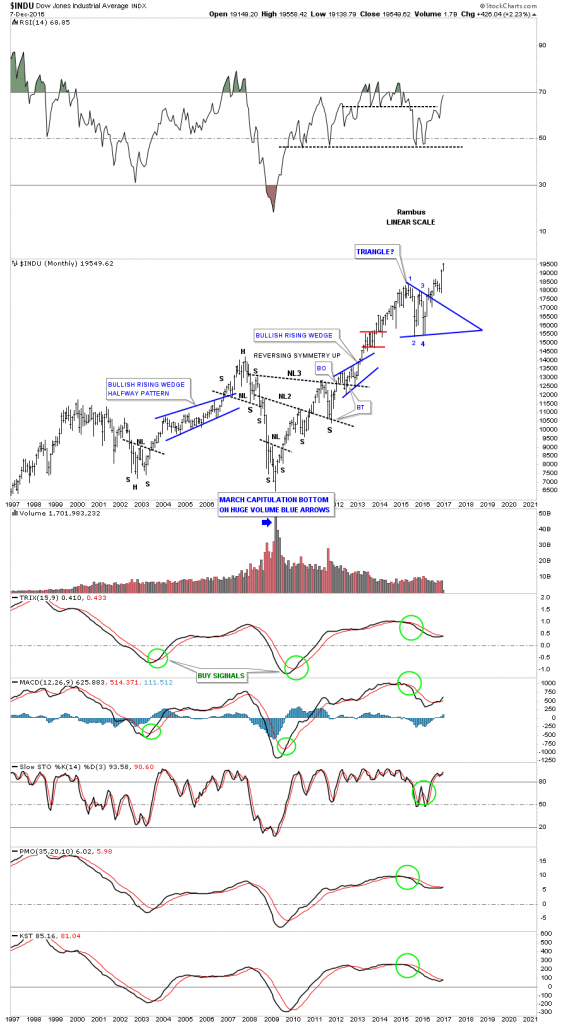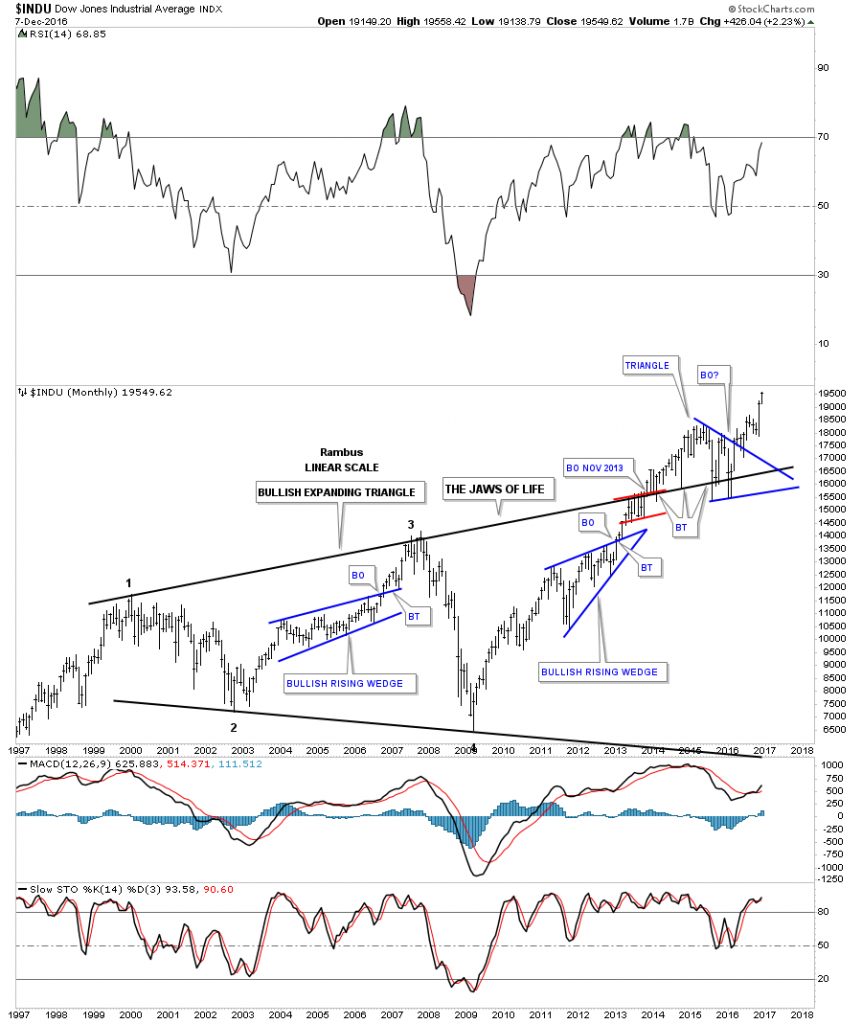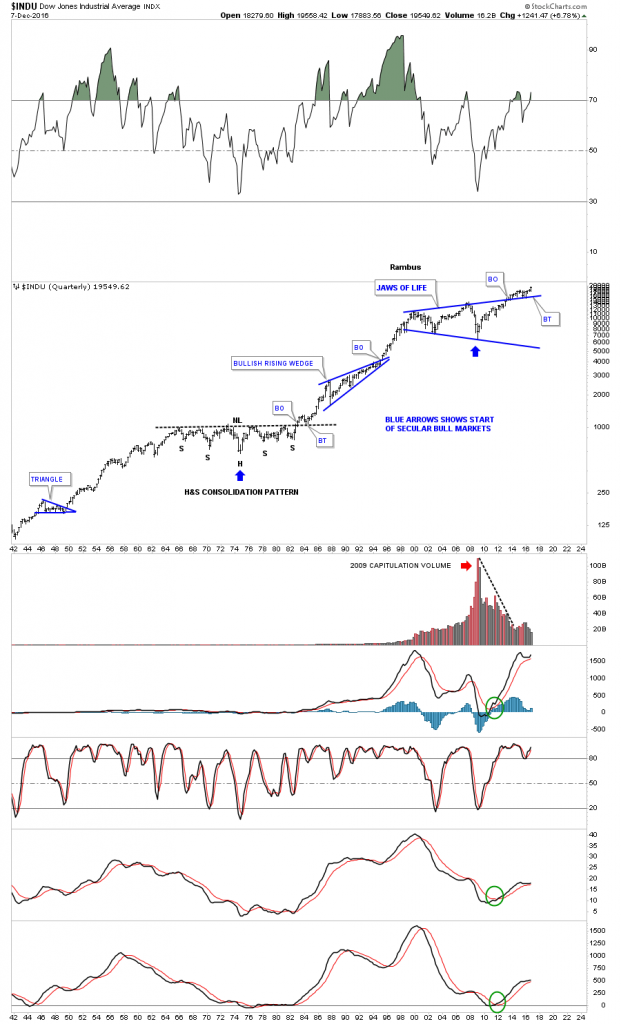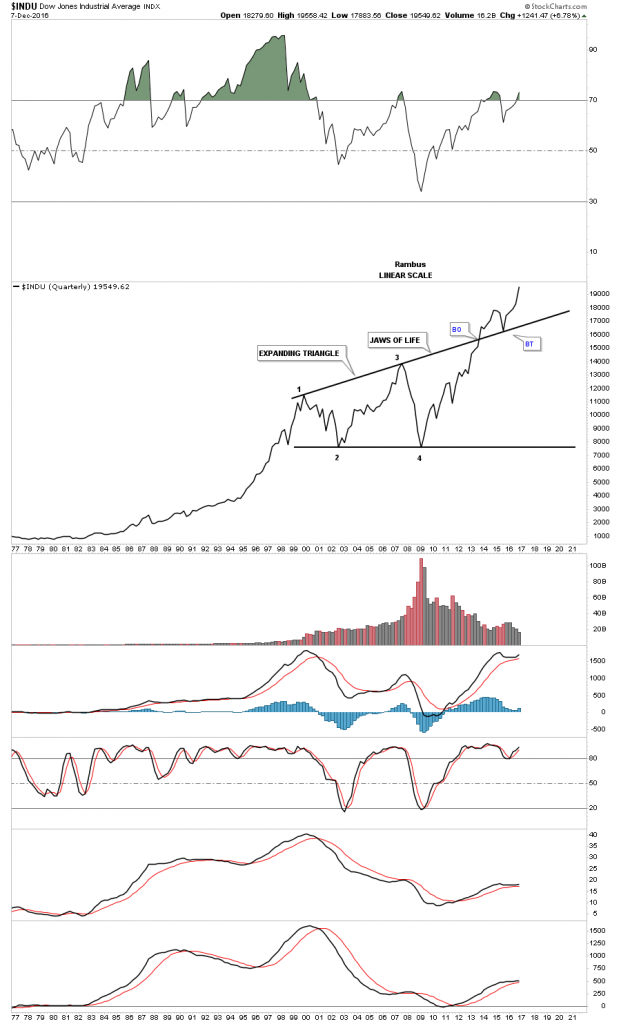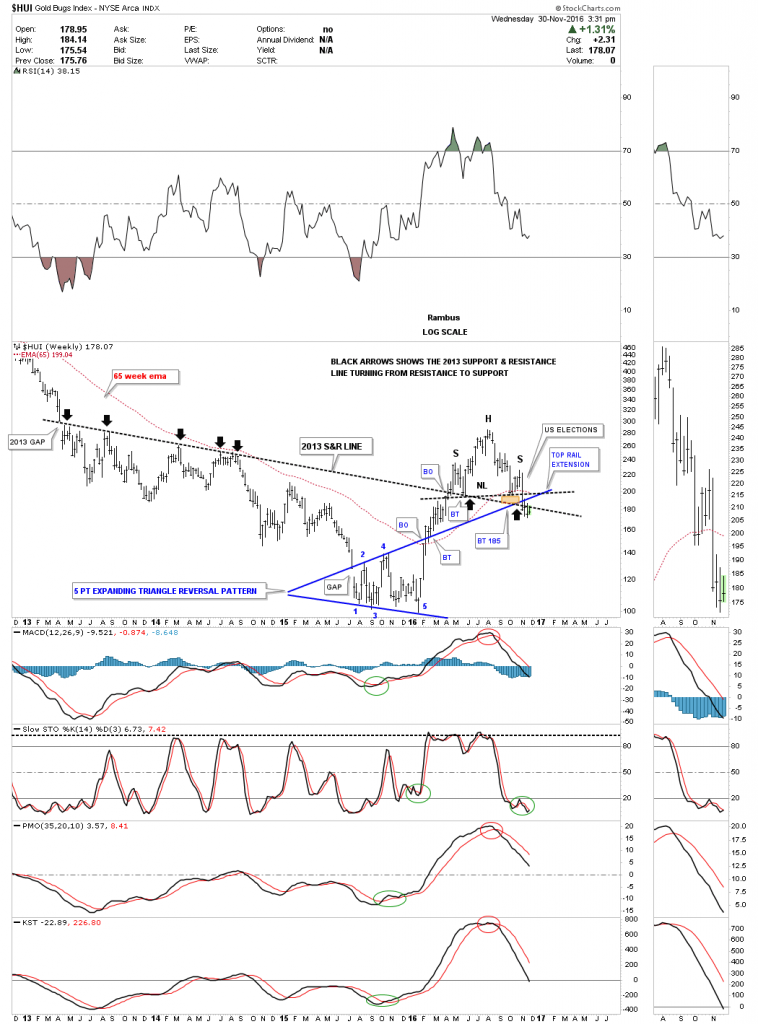Today the HUI is attempting to backtest the top rail of the downtrend channel, trying to close the breakout gap, with the 50 day ma coming in at the 187 area. So far this normal price action after the breakout as long as the top rail holds support. If it fails it will be a warning shot across the bow that the bulls might not be as strong as they appear.
Category Archives: public
Weekend Report Part 2…What IF Gold has a Drop Dead Line ?
In part 2 of this Weekend Report we’ll take an indepth look at gold and especially the long term view. Again, this is just for entertainment purposes only until gold can close below a very important trendline. I’ve been following this potential scenario since shortly after the US elections. Up until the elections this pattern I’m about to show you didn’t show its self, but now it’s one of the most important chart patterns for gold that I’ve posted in several years. As we discussed in part 1 , please read forward with an open mind regardless of what other information you re processing and what your current expectations are. This is an exercise in my preferred method of Technical Analysis , Chartology.
Again, this is an exercise in a “Potential” big picture scenario which has a strong basis in Chartology . It is not a prognostication at this time , but is an important scenario to keep in mind. At the moment there is a rally in the Gold sector and we are short term bullish .
There are three daily charts we’ll look at first, which are reversal patterns that formed at a very critical spot on the long term charts.
I’m going to start with a few daily charts and then work our way back in time to see the big picture. This first chart for gold shows the H&S top which we’ve been following on the PM combo chart that I post several times a week. This H&S top is an unbalanced H&S top with two left shoulders and one right shoulder. Note how the moving averages are crossing to the downside with the 20 and 50 day moving average now having crossed below the all important 300 day moving average. In the not so distance future, if gold keeps dropping, the 150 day will cross below the 300 day ma which will be a long term sell signal.
This second daily chart shows the seven point diamond reversal pattern we looked at shortly after the price action broke below the bottom rail. The seventh reversal point formed on the night of the US elections which put the diamond back into the reversal pattern category as it has an odd number of reversal points. It looks like gold is trying to rally as the decline out of the diamond reversal pattern has been pretty severe. It will be interesting to see how high a bounce may go and if gold starts building out some type of consolidation pattern.
This next daily chart for gold is probably the most important chart for the big picture. This chart shows a bearish rising wedge which began to build out one year ago at the December low. Most folks think this was the beginning of a new bull market, but the bearish rising wedge has strong overtones of a bear market rally. The price objective of a rising or falling wedge is where the wedge begins to build out or the first reversal point. This would be a minimum price objective as prices can go much lower. The top half of the bearish rising wedge is the H&S and the diamond tops we looked at on the charts above. The important moving averages are looking very weak at this point in time.
In part one of this Weekend Report we looked at the morphing process for two important H&S tops on the HUI. This next chart for gold is a long term monthly look which shows the original H&S top I showed you back in 2013 or so. The 2008 H&S consolidation pattern is what setup the neckline that stretches all the way to the left hand side of the chart, as shown by the neckline extension line.
Note the beautiful symmetry as shown by the neckline symmetry line which shows the high for the left and right shoulders. Back in 2014 the price action broke below the neckline and it looked like the H&S top was complete when the backtest took place. Gold dropped into last years December low and rallied backup to the neckline again in a second backtest which so far is holding resistance telling us the neckline is still hot.
As you can see the price objective for the H&S top is down to the 2008 crash low as shown by the brown shaded S&R zone. If gold takes out the December 2015 low it will be creating a lower low, which is not bull market action. So the 1040 area now becomes important support for the big picture.
This next weekly chart focuses in on the shorter term look which shows how gold may be morphing into its own double H&S top. Neckline #1 is shown by the weekly chart above. Neckline #2 is taken from the 2008 bullish expanding falling wedge bottom which is creating the left shoulder. The right shoulder is built from the bearish rising wedge we looked at on the daily chart earlier. Now you can see why the bearish rising wedge is playing such an important role in the big picture.
Note the beautiful symmetry just above neckline #1 which shows gold building out the bullish rising wedge on its way to the bull market high at 1920, and the blue six point triangle consolidation pattern that formed on top of neckline #2 just before gold broke down.
Since I became aware of the potential double H&S top, I always showed the bull market top as a small double top, with the six point rectangle formation building out just below the double top as a consolidation pattern. What I’ve been contemplating recently is how the 2011 top fits into the big picture as the head. A reversal pattern consists of an odd number of reversal points 3, 5, 7 or more. It’s apparent that the 2011 top is a reversal pattern. During gold’s last strong move up in its parabolic run to its all time high at 2011, the price action above the top rail of the six point rectangle consolidation pattern was most likely a throw over or a final capitulation move. We can label the bull market top as a seven point rectangle reversal pattern if we use the capitulation throw over as the seventh reversal point.
This chart also shows why neckline #2 is so critical to the very big picture. As you can see if big neckline #2 gives way, gold will have created a massive H&S top. It looks like 1100 is going to be the magic number that is going to tell us if gold is truly in a bear market that began at the 2011 high. As long as gold can trade above 1100 it will have a positive basis and the massive double H&S top will be negated. On the other hand if gold breaks below the 1100 area then the odds increase very dramatically that gold has been in a bear market since 2011 with a long way to go to the downside before the bear market exhausts itself.
Now I would like to start showing you the very big picture which begins to bring all the pieces of the puzzle together. This first weekly bar chart for gold shows the potential massive double H&S top with the 1100 area being the most important price point for gold at neckline #2. If neckline #2 gives way the price objective will be down to the 500 area, which seems impossible at this time, but big patterns create big moves. Note the multi year base made back in the late 1990’s which launched gold’s bull market that took over five years to build out.
This next chart is a weekly line chart which shows the reverse symmetry patterns for the left and right shoulders. Note how the left shoulder formed a combo H&S consolidation pattern along with the bullish expanding falling wedge. Now look over to the right shoulder and you can see the H&S top with the blue bearish rising wedge. The blue arrows show how gold has been reversing symmetry back down vs how it went up. It’s not a perfect correlation but close enough.
Below is a shorter term weekly chart showing the double H&S top in more detail.
Now, on to the monthly bar chart which shows the parabolic bull market and the strongly slanted H&S top. Again, you can see how the 1100 area is going to be our line in the sand, which will have long term consequences if it the price action breaks below that now very important neckline.
This next monthly line chart for gold has just one trendline, which is the neckline.
This last chart for tonight is a long term monthly look that goes back 50 years and is pretty self explanatory.
We like to think of ourselves as not being part of the herd, but it’s very difficult not to be. With all the information we absorb everyday it’s bound to affect us in ways we don’t understand. If this massive H&S top plays out you’ll be some of the first PM investors that will understand what is really taking place in the precious metals complex. The bottom line is that if the 1100 area at neckline #2 gives way a major long term top will be in place, and big patterns equals big moves. All the best…Rambus
OIL Update…
I actually wrote this post yesterday but got busy and forgot to post it.
The $WTIC is still in the process of breaking out and backtesting top rail of the blue morphing triangle consolidation pattern which is also the possible neckline of an unbalanced H&S bottom. I wouldn’t like to see the price action take out the previous lows made earlier this month.
This next chart is a longer term weekly look which shows the possible unbalanced inverse H&S bottom with the blue morphing triangle forming the right shoulder. You can see from the size of the base oil can have a pretty big move to the upside. The bigger the base the bigger the move.
About three weeks ago the XLE broke out of a 10 point bullish rising flag on a nice increase in volume. It’s important for the top rail to hold support if there is a backtest at the 73.60 area.
The OIH weekly chart.
Weekend Report…Precious Metals New Bull Market or Bear Market Rally ?
Buckle Up ,Pour yourself your favorite beverage , and take some time . This Report will be an in depth Chartology analysis of the current situation in this ever interesting and often exasperating market we are participating in. Oh and don’t forget to open your mind. Lets begin.
I would like to start the Weekend Report by looking at a combo chart which has the US dollar on top and gold on the bottom, which shows you a better version of the positive divergence the US dollar had vs gold in 2011. First note the red arrows on the US dollar and gold back in 2008 when gold was making a high, and the US dollar was making a low, which is what you would expect. Now look at the two red arrows in 2011 whch shows the all time high for gold and a higher low for the US dollar vs the 2008 low. Gold rallied almost 1200 points to its 2011 bull market high, but the US dollar made a higher low. If they were on an equal footing the US dollar should have traded much lower when gold was making its all time high. That’s how I viewed the positive divergence for the US dollar vs gold.
The blue arrows on the US dollar chart on top shows how I was, and still am looking for reverse symmetry to the upside based on how the dollar came down when it started its bear market in 2000.
The two heavy black dashed horizontal lines on the gold chart at the bottom are still original from when I built this chart. I have adjusted the downtrend channel, and what was the falling wedge, I’m now annotating it as a bearish expanding falling wedge. During the construction of the original three year falling wedge I always labeled it as a bearish falling wedge and thought it would eventually breakout to the downside until last year at this time.
You can see the original falling wedge when you look at the mid dashed line of the downtrend channel, and the bottom rail of the blue expanding falling wedge. There is no doubt that the S&R line at 1040 did indeed hold support after being tested several times from above. That rally took the price action up to the top rail of the downtrend channel and the top rail of the blue expanding falling wedge, which looks obvious now. It was that H&S top on gold we’ve been following since the US elections, which was the frosting on the cake in showing a reversal pattern at that critical juncture.
One last note on this combo chart. As you can see the US dollar is breaking out to new highs, while gold has failed to take out the 1040 area. What I’ll be watching very carefully as the US dollar continues to make new highs, is that we should see gold take out the 1040 low for more confirmation, gold is still in its 2011 bear market.
This next chart for the US dollar is a daily line chart which shows the rectangle with four completed reversal points with a breakout and backtest to the top rail. To negate the breakout we would have to see the dollar trade below the top rail on a daily closing basis, until then the breakout is valid.
This next chart focuses on the impulse move up in the US dollar that began in mid 2014. I ended the time for this chart to April of this year so you could see the big impulse move up more clearly. This chart shows you exactly what a strong impulse move looks like by forming one consolidation pattern on top of the next. Note the beautiful black bullish rising wedge which formed in the middle of that big impulse move, that was made up of two smaller consolidation patterns. There was a breakout gap above the top rail with a nice clean backtest which confirmed the black rising wedge was a bullish rising wedge. There is a strong possibility that we may see something similar to this impulse leg up in our current leg up.
This next chart for the US dollar is a forty year look we’ve been following for a very long time which shows the massive bullish falling wedge. Note how the blue rectangle has formed as the backtest to the top rail of the bullish falling wedge, and the neckline extension rail that formed that massive 2000 H&S top. What actually led to the breakout from that 40 year bullish rising wedge was when big base #2 finally matured and broke out. What is hard to even imagine right now is that the price objective of that 40 year bullish falling wedge is to where it began to build out, which is all the way up to 160 back in 1985. It will take many years for the US dollar to reach that price objective, and what will it mean for everything that is affected by the US dollar.
This next chart is a combo chart which has the US dollar on top and the SPX on the bottom. This chart shows how the US dollar and the SPX rose together during the last five years of the bull market that ended in 2000. Not so much on the SPX, but on many other index charts I always viewed the rally from 1995 to the 2000 top as the runaway or acceleration move into the bull market top, which is how most bull markets end.
Below is another combo chart which has the US dollar on top and gold on the bottom. I built out this combo chart right after the US elections as something dramatically had changed. The US dollar still hadn’t broken out yet and gold was still trading at the top rail of its downtrend channel, but in just six weeks or so you can see how things have really changed for these two.
This next chart is the gold to US dollar ratio chart whch shows that H&S top forming right at the 2016 high just below the top rail of the downtrend channel. That is the same area on the gold chart above, which is reversal point #3, top of the blue bearish rising wedge.
Next I’m going to bring out some old charts we haven’t looked at since the bear market years. This first chart is a daily chart for gold that shows one of the most symmetrical H&S consolidation patterns I’ve ever built out. I won’t get into the details as it’s explained in the annotation box. What is most important about this chart, other than its symmetry, is the heavy dashed black neckline. That neckline played a key role several years later as some of the longer term members may remember. After the top was finally put in at the 1920 area I was looking for a big correction, or even a bear market to begin building out. There is an old saying in Chartology, that an important trendline never dies it just slowly fades away, which I’ll show you in a bit.
Here is the long term monthly chart for gold I first built out in 2013 right after gold bounced off the neckline symmetry line which is taken from the chart above, and extended out in time to the right. There is some really nice Chartology on this chart starting with the neckline symmetry line which showed us the high for the right shoulder which is taken from the massive 2008 neckline extension line. What also happened at the right shoulder high in 2013 was the classic backtest to the underside of the bottom rail of the the expanding bull market uptrend channel.
Gold chopped around on top of the neckline extension line for close to a year creating the right shoulder before it finally broke to the downside in 2014 completing the right shoulder. There was a fairly strong backtest from below to the 2008 neckline extension line, but gold quickly broke below the neckline again, and began to decline in earnest right into last years December low.
I have to admit that I didn’t really think gold was starting a brand new bull market but I had no choice but to go with the rally. I was firmly in the bear camp but when the HUI and other PM stock indexes were showing bottoming patterns there was the possibility that maybe the PM complex had bottomed and was beginning a new bull market. Note the second backtest to the neckline, which occurred this past August. Again, it was a fairly strong backtest, but that is the place where the H&S top and the diamond reversal pattern formed, which is another big clue the second backtest would be successful. That price objective has been on this chart since the middle of 2014 which is down to the 685 area which also coincides with the 2008 crash low. More confirmation that gold is headed to its H&S price objective down at the 685 area will be when we see it trade below its previous low at 1040 or so.
Below is just a simple uncluttered look at the massive H&S top.
This next chart is one we haven’t looked at in a very long time, which is the fanline chart for gold going all the way back to the beginning of the bull market in 2000. The rule of thumb for fanlines is that once they are broken to the downside you generally will have a backtest to the underside before prices break lower again. The other rule of thumb for the fanline pattern is that once the third fanline gives way the pattern is complete. Note the backtest to the underside of fanline #2, which you can see on this long term monthly chart, which is the H&S and diamond reversal patterns on the daily chart that formed that backtest.
As you can see fanline #3 is just starting to break down so don’t be surprised if we see a backtest to the underside at some point in time. If we do then it will represent a very low risk entry point to go short with a close above the fanline as your exit point.
If gold is building out a massive H&S top then we should see something similar with silver. Again here is an old chart I pulled out from the past that is still relevant. Just like gold, silver to has built out a massive H&S top that shows some nice symmetry using the neckline symmetry line to find the high for the right shoulder. Actually, silver had a cleaner backtest to the underside of the massive neckline this summer than gold.
Below is a 20 year monthly chart for silver which shows the massive H&S top and the price objective down to the 6.25 area. The first real area of support should come in around the brown shaded support and resistance zone. Keep in mind the neckline and neckline symmetry rail were put on this chart back in 2014. I should have been paying closer attention, but with everything at major inflection points it’s hard to keep track of everything to the letter. The main thing is that this next impulse leg down is really just getting started. A break below the 2015 low will be more confirmation the downtrend continues.
This last chart for silver is a 45 year monthly chart which shows the massive inverse H&S bottom that led to silver’s bull market all the way up to its 1980 high at $50. You can see the clean breakout and backtest to the neckline from our current H&S top, as shown on the charts above. I extended the neckline out in time to the right hand side of the chart which would be the first real logical area of support at the 7.65 area.
Next lets look at some ratio charts to see what they may be telling us. This first ratio chart compares gold to the CRB index. The last time we looked at this chart it was just breaking down from the five point triangle reversal pattern. This chart suggests gold is going to under perform commodities for awhile.
Below is a 50 year monthly line chart for the gold to CRB index which is showing the ratio has put in a double top at the very top of the five year blue expanding rising wedge. It looks like this ratio won’t find support until it hits the bottom rail around the 4.50 area. Keep in mind this is a very long term chart.
I know some folks think that very large consolidation patterns don’t work, or are useless. This fifty year chart shows a 25 year bullish falling wedge as a halfway pattern to the upside. Also note how gold has been outperforming the CRB index since the last low in the bullish falling wedge. It might be time to see the CRB index really start to outperform gold now, for an extended period of time.
This next chart is a ratio combo chart which has the INDU to gold ratio on top, and gold on the bottom. Since the US election the ratio chart on top has broken out and made a new high for this move. Gold on the bottom chart shows that H&S top which has been showing up in so many different areas in the PM complex. Since the low in 2011 on both the ratio chart and gold, the INDU has been outperforming gold in a pretty big way.
Below is a 35 year ratio chart that compares gold to the INDU. This ratio is just now breaking out from a large H&S bottom. Note how once the big trend gets established it can run for many years. In the 1990’s the INDU was the place to be. From 2000 to 2011 gold was the place to be invested. Many thought this ratio would drop all the way down to 1 to 1, like it did in 1980 when gold was at 850 and so was the INDU. As you can see the ratio only made it down to 5.5 this cycle.
Earlier this week we looked at this long term ratio chart which compares the XEU to the US dollar. The last time we looked the ratio was sitting right on the bottom rail of the blue expanding triangle, but as you can see it is now trading below that very important bottom rail. As this is a monthly chart I would like to see the ratio trading below the bottom rail by months end.
The XJY to the US dollar ratio chart is showing the price action fast approaching its massive neckline.
Also earlier this week we looked at the XSF to the US dollar trading right on its massive neckline, which now shows the price action working its way lower. Is it just a coincidence that these currency pairs are all testing their major long term necklines while the US dollar breaking out of an important consolidation pattern?
I would like to finish up by looking at some charts for the HUI starting with this long term weekly fanline chart which goes back to the 2000 low. You can see there were H&S tops that built out just above fanline #1 and #2 which suggested the fanlines would would give way.
Fanline #3 is interesting as it built out the blue triangle consolidation pattern which gave the HUI the energy it needed to break the fanline. Shortly after the breakout from fanline #3 the HUI built out a small H&S top just below it, which suggested the fanline pattern was complete, and the decline would ensue. The HUI did indeed decline all the way down to the January low this year where it put in a double bottom. The rally out of the January low was very impressive and it looked like a brand new bull market was just beginning, which most believe is the case today.
There is one really big issue the HUI has to overcome and that is to trade above fanline #3 to confirm the bull market is real, and this wasn’t just a bear market rally. As you can see the price action hit fanline #3 for the second time back in August of this year and built out a second H&S top just below it. Keep in mind that H&S top is a reversal pattern that is reversing the bull run out of the January low. The double bottom at the January low was a reversal pattern that reversed that last leg down in the bear market.
Below is just a simple weekly line chart for the HUI which shows the massive H&S top which reversed the secular bull market and the two smaller H&S top we looked at on the fanline chart above.
Some of you may remember when I posted this weekly chart for the HUI shortly after it broke back down below the all important 2013 support and resistance line. The black arrows shows how it held resistance for several years and then was finally broken to the upside during this years rally. Shortly after the S&R line was broken to the upside earlier this year it had a clean backtest and all seemed right with the world regarding the HUI and the precious metals stocks in general. The little brown shaded area shows where I thought we would see good support come in just like the last time. We did get a little support but the rally wasn’t very strong and built out the right shoulder for the H&S top.
I mentioned several weeks or so ago, when the 2013 S&R line gave way and the HUI was trading below it, that we could now see a backtest to the underside because it’s a support and resistance line, above is bullish and below is bearish. As you can see it held resistance for the last six weeks and now the HUI is starting to fall away. The HUI also failed to trade above the top rail of the blue expanding triangle bottom reversal pattern extension line.
This next chart is a long term monthly look at the HUI which again shows its massive H&S top and the bear market that followed. This chart shows why it’s important to recognize reversal patterns as soon as they become clear. Note the double bottom which looked like it was the bear market low because it’s a reversal pattern and the price action did indeed reverse back to the upside. Now however you can see the H&S top that built out and is now reversing the uptrend to a downtrend. What this is doing is creating a very large trading range between 100 on the bottom and 285 at the top. There is no law that says the HUI has to trade all the way down to 100. If the price action makes a higher low that the January low a triangle could develop, but that’s getting to far ahead of ourselves.
These last couple of charts for the HUI are daily charts which I think have a possibility of playing. If you’ve been following the HUI you will know it has put in a series of three small consolidation pattern since topping out in August of this year. These three consolidation patterns have built out a fairly parallel downtrend channel as shown on the chart below.
In fast moving conditions, which I think the PM complex is in right now to the downside, there are a couple of things that can happen. In the case for the HUI I think if the bottom rail of the current downtrend channel is broken to the downside we will see a doubling of the upper channel as shown by the black rectangle measuring sticks. The current bottom rail of the downtrend channel would be the mid dashed line on this chart below, which shows what a doubling of the upper channel would look like. To set this possible scenario in play would be to see the HUI break below the dashed midline in a fairly convincing fashion.
Again if the PM complex is in a strong impulse move down this last chart for tonight shows a possible bearish falling wedge on gold. We should get our answer to this question in the next few days.
What I tried to do tonight is paint a picture of the long term status for the PM complex based on chart patterns, currencies pairs, ratio charts and combo charts, coming from many different areas. What all these charts above are strongly suggesting to me is that the rally out of the January low, made this year, was a bear market rally and not the start of a new bull market for the precious metals complex. I know this is a hard pill to swallow but until the bulls can start showing some strength, the bears seem to be in charge. Keeping ones trading capital safe is more important than anything else when it comes to the markets. There will be many more trades if one has the capital to take advantage of the situation when the time comes. This trade in the PM complex started out very good this year, and a good time was had by all. Knowing when to leave the party can be a totally different scenario.
I have to go back down to Little Rock today so I’ll be out of the office on Monday. All the best…Rambus
Wednesday Report…Precious Metals Now What ?
I had a completely different post in mind for tonight, but the action in the PM complex has changed my mind. Since the US elections the PM complex has had a hard go of it trapping many bulls in their long positions. The magnitude of this decline especially in gold has been unrelenting in nature, which is how a bull trap is set. Just a short five weeks ago all looked good for this sector as it had one of the biggest rallies in history off the January low for the PM stocks. There wasn’t anything to suggest that five weeks ago the plunge was coming, but since then, there have been many clues that all was not right with the PM sector.
I’ve covered most of the reasons why I thought the PM complex would be having a hard time in many posts over the last five weeks or so. Tonight I would like to update some charts on why I think the bear market isn’t over yet and why I think there is more pain to come. This could all go out the window tomorrow, but for right now, these charts to follow shows some of the reasons why the PM complex may need to fall further.
First I would like to start by looking at the two hour chart for the UUP which broke out of a H&S consolidation pattern today during the last two hours of trading on heavy volume. I know there are many reasons why the US dollar can’t keep going up, but the H&S consolidation pattern has formed as a backtest to the top rail of the year and a half bull flag. Below is the two hour chart for the UUP.
This next chart for the UUP is a daily look which shows the last impulse move up and the year and a half black bull flag complete with a breakout gap. Note the almost one year H&S bottom that formed at the last reversal point before the breakout. The rally out of the mid summer 2014 low shows you what a strong impulse move looks like, as there is a series of one consolidation pattern forming on top of the next until the price action becomes exhausted and begins to correct that big move. When all is said and done the black bull flag should look like a halfway pattern forming between the first impulse leg up, and the impulse leg that started at the fourth reversal point in the black bull flag. We have a very clean line in the sand with the top rail of the bull flag, above is bullish, and below is bearish.
Below is a weekly chart which shows the bull flag with the 13 and 34 week crossovers for a simple buy and sell signal. Note the big breakout volume when the UUP gapped above the top rail of the bull flag. This is not a false breakout unless the UUP trades back below the top rail of the bull flag. Until that happens the breakout continues to evolve, and one should go with it instead of fighting against it.
This last chart for the UUP is another long term weekly look which shows the initial downtrend channel that formed between 2008 and 2014. Note the blue bull flag that formed just below the top rail of the black downtrend channel which gave the UUP the energy it needed to finally breakout and run to the high made in 2015, which began our recent consolidation pattern.
This next chart is a ratio chart which compares GLD to the UUP. When this ratio is falling GLD is weaker than the US dollar. The last time we looked at this chart the ratio had already broken down from the H&S top with a price objective down to the 4.16 area as a minimum downside move. The red arrows also shows you how I was expecting some possible reverse symmetry down.
This long term chart for the gold to the USD ratio chart shows the bull market uptrend channel and the bear market downtrend channel that has been building out since the 2011 high. Where that small H&S top that recently formed just below the top rail of the downtrend channel, was a big clue that gold was in trouble which is the same H&S pattern on the daily chart above.
This next ratio chart compares the XEU to the USD going back some 25 years. Keep in mind this is a long term monthly chart so things move at a snails pace. You can see the massive topping pattern that has led to the most recent lows. For almost two years now this ratio has built out an expanding triangle which I believe will end up being a halfway pattern to the downside. It took nearly seven months for the XEU to find support at the first reversal point in the blue expanding triangle. We could very well see a similar move down in this ratio once the price action breaks below the bottom rail.
This next chart is a weekly look at the DBC, commodities index, which shows you a good example of how the blue expanding triangle worked out as a halfway pattern to the downside.
This next ratio chart compares the XJY to the USD which is forming a massive H&S top. Note how the neckline symmetry line showed the high for the right shoulder.
This last ratio currency chart compares the $XSF to the USD. As you can see, this month the ratio is cracking the neckline. What all these long term currency ratio charts are suggesting is that the US dollar has a long ways to run to the upside. I know it goes against conventional wisdom but what is conventional wisdom? I’ll have many more charts in the Weekend Report to show you that I hope will paint a clear picture on what is actually taking place right now in the PM complex. All the best…Rambus
End of the World History Chart…
I try to show this long term monthly chart for the $COMPQ which I call the “End of the World History Chart” at least once a year or if something interesting takes place. When you look at the 1987 crash it felt like the end of the world at the time but that ended up being the second reversal point in the green bullish rising channel. How many remember the months leading up to the first Gulf war in 1991? No one knew at the time how that conflict would play out as the US was going up against the 5th largest army in the world. On the first night of bombing it was very clear that the conflict would be over quickly and the stock markets took off the very next day which made the fourth reversal point in the green bullish rising channel.
Which also helped put that fourth reversal point in the green bullish rising channel was the Savings and Loan crises which was dominating the headlines at that time. As you can see the COMPQ launched into one of the greatest bull markets of all time that ended nine years later when the tech bubble finally burned out.
How many remember the crash in 1998 that doesn’t look like anything on this chart but it was the LTCM, Long Term Capital Management debacle that felt like the end of the world at the time. It’s easy to look at a chart like this and see how important events in the world look in hindsight but when you are living and trading during one of these events it’s a totally different story.
After the $COMPQ topped out in 2000 it declined in a very strong move down building out the green bullish falling wedge which broke to the upside during the start of the Iraq war. The markets were crashing and the US was going to war. It doesn’t get much more negative than that but that was the low. I know most of you are familiar with the 2009 crash low which felt like the end of the world at the time but as you can see it launched a seven year bull market that is still making new all time highs.
The last chart pattern on the right hand side of the chart is the little red bull flag that just completed a backtest to the top rail last month and is now making new all time highs. The fourth reversal point on that little red bull flag was the BREXIT vote that tanked the markets which quickly reversed back up after just a couple of days.
The last point I would like to make with this chart is shown by the ten year blue triangle consolidation pattern. Note how clean the breakout and backtest was to the top rail which began the formation of the red bullish rising wedge. There are many individual stocks that made a similar consolidation pattern that have broken out and are well into new all time high territory. When looking at this big picture you can see how the blue ten year triangle consolidation pattern is forming as a possible halfway pattern which should show a similar move leading out of the triangle to the one leading into the triangle.
I’m viewing our current breakout and impulse move up, could take the price action up to the black dashed mid line before we see a decent correction. The move up could resemble the move up out of the red bullish rising wedge which would then show the red bull flag as a halfway pattern. The good news is this next impulse leg up is just getting started. As long as the game plan keeps play out this is how I see things unfolding over the coming years which will be punctuated with some strong corrections and maybe even a black swan event such as the 1987 crash which ended up being a great buying opportunity. I will have a ton of charts to post tomorrow that will shed some more light on the big picture which is the most important time frame to get right. If you know and understand the big trend it is so much easier to stay in the game. There are times when one can trade against the dominate trend but it’s much more difficult to do, the trend is your friend.
Precious Metals Chartology …Just the Facts Man
This first precious metals combo chart is one I try to show you at least twice a week so you can follow the price action as it’s unfolding in real time. Except for SLV the other indexes have now traded below their respective neckline for five weeks now. If you look at the sidebar you can see which sectors are doing the best and which ones are weakest. As you can see GLD has been by far the weakest of the four while SLV has been the strongest. To negate these H&S tops we would need to see the price action close back above the necklines. The necklines are your lines in the sand, above is bullish and below is negative.
This next combo chart is also one we’ve been following very closely which shows the multi year trading ranges which were broken to the upside earlier this year. Those big top rails should reverse their role from what had been resistance to now support which they’ve done so far.
Now lets look at the thin black dashed horizontal lines which represents support and resistance. During the strong bear market move back in 2013 you can see how they reversed their role to what had been initial support to resistance once the price action broke below those S&R lines. Looking at the right hand side of the chart you can see the same thing taking place since the August highs.
Following the price action is just that, following what the charts are showing us and not trying to second guess what we may think we want to see,, which is a lot harder than it seems. Note how the HUI and GLD are now testing their top rails from above. As long as those top rails hold support then all is good for the PM complex. On the other hand if we see those top rails broken to the downside then the PM complex will be talking to us from a bearish perspective regardless of all the reasons why the PM complex can’t go down.
Wednesday Report…The Jaws of Life : (The Most Hated Bull Market in History)
Tonight I would like to update the INDU we’ve been following which continues the upside move since the night of the US elections. Keep in mind some of these consolidation patterns began to form back in 2015 which had nothing to do with the US elections. It’s the billions upon billions of shares that were traded which produced this breakout move that is now being recognized for what it is. Even at this stage of the breakout move, there will be many doubters who will never recognize what is actually taking place. It can be very difficult to think outside of the box when we are bombarded everyday on how bad things are and how bad things are going to get. There has to be the proverbial wall of worry in order to have a bull market. Once the bull market becomes mature then the wall of worry comes down, and everyone is invited to invest in the markets, which will be at the blow off phase like in 2000.
I would like to start by looking at a daily chart for the INDU which I first showed you back in early November of this year, which was consolidating in an eight point bullish falling wedge. Just before that bullish falling wedge the INDU built out another small consolidation pattern which was a bullish expanding falling wedge. Note the breakout from the bullish expanding falling wedge which failed to rally very strongly before the INDU began to correct, and formed the eight point bullish falling wedge. Whenever you see a nice tight consolidation pattern fail to reach its price objective it tells you one of two things. First, the original pattern may be morphing into a bigger pattern. The other possible scenario is a second small well defined consolidation pattern that forms on top of the lower one, which can produce a rising wedge which is the case for the INDU.
The last time I posted this chart I suggested most would see this rising wedge as a bearish rising wedge, and the INDU would collapse into a bear market. Through the years I’ve shown you countless rising wedges that broke to the upside, which always suggest the move is very strong. A consolidation pattern that is slopping up in the same direction of the uptrend instead of against the trend, would be your typical bull flag. Today the INDU finally broke out of the bullish rising wedge with a nice long bar. If we get a backtest to the top rail it would come in around the 19,250 area. One last note on this daily chart, which shows reversal points #2 and #4, on the bottom rail of the black bullish rising wedge, were the BREXIT and US Elections Shocker. Now ain’t that something !
I’m going to work backwards in time so you can see how this small bullish rising wedge fits into the big picture which is most important to understand from the intermediate to long term perspective. Below is a two year chart for the INDU which shows all the trading patterns which led to today’s breakout move.
This next chart for the INDU is a five year look which starts to paint the bigger picture. From the middle of 2015 to the middle of 2016 the INDU built out a nice big triangle consolidation pattern. The breakout and backtest to the top rail was the bullish expanding falling wedge we looked at on the first chart above, with the bullish falling wedge just above it. This is what an impulse move looks like starting at the January 2016 low.
This next chart is a long term weekly look which shows the H&S top that formed back in 2007 before the crash, and then the 2009 inverse H&S bottom which started the most hated bull market in history. Note how the current blue triangle consolidation pattern is starting to stick out like a sore thumb. The markets do one of three things. First, they are building out a reversal pattern, secondly a consolidation pattern, and thirdly they are in an impulse move between a reversal pattern or between consolidation patterns.
Below is a shorter term weekly chart which shows a simple trend following technique using just the 30 and 88 week moving averages. During the formation of our recent one year triangle consolidation pattern we did get a negative crossover, but that was negated when the 30 crossed back above the 88 week ma. Keep in mind I’m trying to trade the intermediate to the longer term horizon, which is where I feel most comfortable. Once the moving averages become properly aligned there is little to do but follow the price action. As you can see a buy signal was given way back in late 2009 and we didn’t get a sell signal until late 2015. There were several tricky areas when the price action traded below the moving averages for a short period of time but they never crossed to give a sell signal.
Here is a twenty year look at the monthly chart for the INDU which shows you the most hated bull markets in history. From a Chartology perspective it has to be one of the prettiest bull markets which is now rivaling the great bull market in gold from 2000 to 2011.
This next twenty year chart for the INDU is where I have for a long while disagreed with just about everyone else. I’ve been showing this 13 year black expanding triangle, JAWS of LIFE, for several years now waiting patiently for all the work to be completed between the breaking out and backtesting phase. I can honestly say I finally feel vindicated after all these years watching this pattern which was being called the “Jaws of Death” develop and waiting for the INDU to make new all time highs above the blue triangle that formed as the backtest. Remember big patterns equals big moves.
This next chart for the INDU is a 75 year quarterly look which I don’t expect anyone in there right mind to believe except those that have their mind open. With that said the INDU is embarking on a multi year secular bull market that began in 2009. Note the beautiful H&S consolidation pattern that formed in the late 1960’s and 1970’s that finally broke out in 1982, with one last backtest to the neckline, which began the greatest bull market of all time. Now you can see how the Jaws of Life pattern fits into the very big picture. The 2009 crash low actually started our current secular bull market that will run for many years to come. It won’t come without any corrections, but the big trend is up after a nearly ten year consolidation pattern, Jaws of Life. Note how the top rail of the Jaws of Life has held support as the backtest and now the INDU is making new all time highs almost on a daily basis now.
This last chart for the INDU is a quarterly line chart which really brings things home, IMHO. As you can see there are four reversal points made within the Jaws of Life consolidation pattern. There was a nice clean breakout with an equally clean backtest to the top rail. I can guarantee you that you will not see the INDU presented in this fashion anywhere else on the planet. I have many more charts, in different areas of the markets that I’ll post in the Weekend Report that will give credence that the Jaws of Life is in fact the real deal, and the secular bull market that started in 2009 has a long time to run albeit, with some corrections along the way.
I know how hard it is for most folks to even imagine that the stock markets are in a secular bull market, but just think back to the bottom in 2009. Could you have imagined the INDU would be pushing 20,000 in 2016? If the markets have taught me one thing through the years, that would be to keep an open mind above everything else. All the best…Rambus
HUI Update…To Catch a Falling Knife ?
I’ve been showing you this long term weekly chart for the HUI which shows the all important 2013 support and resistance line. As you can see it held resistance as shown by the black arrows pointing down. Then back in the spring the HUI broke out above the 2013 S&R line with a nice clean backtest which was a very bullish setup. Once broken to the upside the S&R line should reverse its role to support which it did until four weeks ago when the neckline gave way after the US elections.
Note the big long bar that formed during the breakout from the H&S top. That breakout move not only took out the neckline it also took out the 65 week ema, the 2013 support and resistance line and the top rail of the five point expanding triangle reversal pattern that reversed the bear market. Note how the top rail extension line from the expanding triangle and the 2013 S&R line have now been working as resistance over the last four weeks. Anything is possible in the markets, but when you see critical support being taken out like this you don’t have to be a hero and try to catch a falling knife so you can claim you called the bottom. JMHO.

